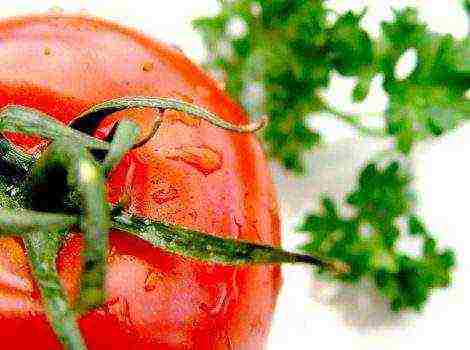Content
- 1 Summer pear varieties
- 2 Winter
- 3 Late
- 4 Autumn
- 5 Pear for the Volga region and central Russia
- 6 Garden varieties for the Moscow region, description
- 7 Why late varieties of pears are good
- 8 Belarusian late
- 9 Bere winter Michurina
- 10 Far East
- 11 Winter kubarevidny
- 12 Nika
- 13 May Day
- 14 Saratovka
- 15 Saint Germain
- 16 January
- 17 Summer pear varieties
- 18 Winter
- 19 Late
- 20 Autumn
- 21 Pear for the Volga region and central Russia
- 22 Garden varieties for the Moscow region, description
- 23 Why late varieties of pears are good
- 24 Belarusian late
- 25 Bere winter Michurina
- 26 Far East
- 27 Winter kubarevidny
- 28 Nika
- 29 May Day
- 30 Saratovka
- 31 Saint Germain
- 32 January
As you know, pear varieties are subdivided into winter, autumn and summer varieties. Each category differs not only in terms of ripening, taste, but also in terms of storage of fruits... So, which varieties can be attributed to winter, and which ripen in summer, see the description below.
Summer pear varieties
August dew
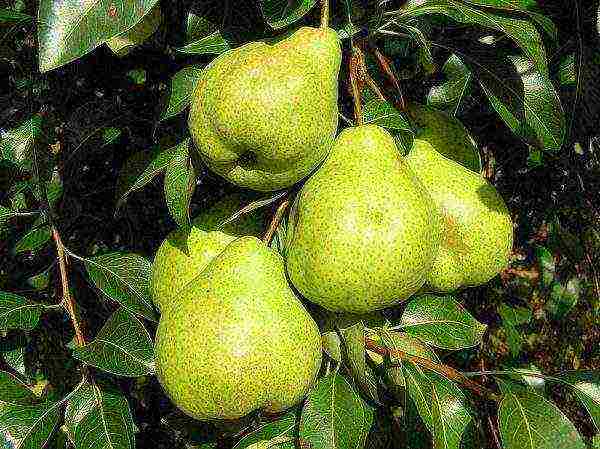 Pear August dew
Pear August dew
The undisputed favorite among summer pear varieties is August Dew, the result of a crossing of Tenderness and Triumph Pakgam varieties. The tree is rather low, less than 10 m in height, the bark is gray, smooth, the buds quickly "wake up" after winter. Branches are spreading, slightly drooping, curved. The leaves are oblong, medium in size, dark green in color. Fruits are of medium size, ripen in mid-summer. The taste is quite sweet, juicy, with white pulp and delicate skin.
Unfortunately, it is not suitable for long storage, the pear quickly turns brown and disappears. It is itself resistant to diseases and pests, easily tolerates winters, bears fruit every year, increasing the number of fruits. The disadvantage of this variety is that it constantly needs to trim the crown, because of this, the fruits become smaller.
Bere Giffard
 Pear variety Bere Giffard
Pear variety Bere Giffard
The same applies to summer varieties of pears. They differ from other varieties with their "ruddy" fruits, red-orange tones on one side of the pear, and light green shades on the other side. Formed on a branch in bundles, from 2 to 6 pieces, and keep that way until fully ripe. Due to the high yield, additional supports are often required, otherwise the branches may break under the weight of the fruit.
The fruits are tender, have a sweet taste, juicy, with white flesh. The tree reaches more than 10 m in height, a sparse crown, branches are slightly drooping and thin. The crown is brown, peels off. The leaf plate is dark green, oblong, with smooth edges. The variety does not tolerate severe winters, therefore, young seedlings require shelter.Fruits are poorly preserved when plucked, no more than a week.
Victoria
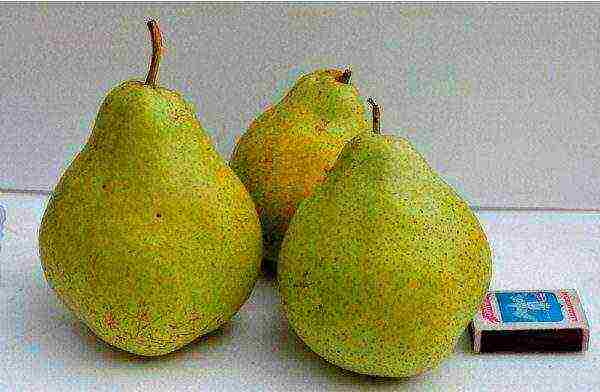 Winter-hardy pear variety Victoria
Winter-hardy pear variety Victoria
This variety is distinguished by its winter hardiness, is not afraid of drought and is rarely exposed to diseases and pests. It appeared as a result of crossing the varieties Bere Bosk and Tolstobezhka. Medium tree, 8-10 m, with a dense crown, has a pyramidal trunk shape, branches are long and thin. The variety is characterized by late vegetation, flowering. Productivity is high, more than 150 kg of harvest is harvested from an adult tree per year.
The pear begins to ripen in the second half of August, reaching its peak of maturity only by the middle of September. The fruits have a regular pear-shaped shape, with a smooth and thin skin.... The pear tastes sweet, with juicy pulp, and has a pleasant aroma. It is good to make jam and jams from this variety. But the pear is stored for a short time, in a torn form it does not deteriorate for about 3 days, it can hang on the tree for no more than a week, then it falls off.
Victoria is only half pollinated. To increase yields, it is recommended to plant it next to varieties such as Bere Dumont,
Williams
Red.
Duchess
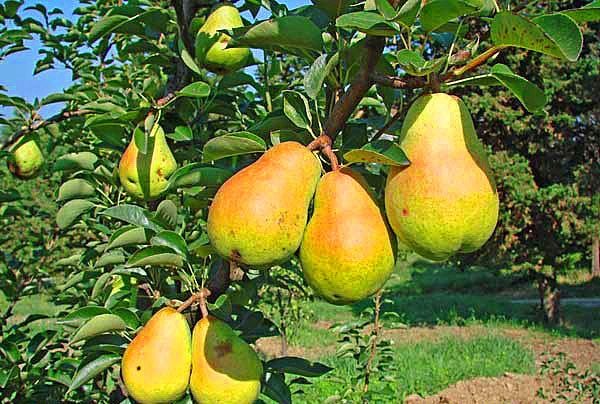 Summer pear variety Duchess
Summer pear variety Duchess
The name of the variety, translated as Duchess, was bred by an English breeder in Wheeler. The tree is not tall, 6-7 m, with a dense crown, branches are spreading, thin... The crown is a light brown tree, smooth.
Fruits begin to ripen in mid-August, the fruits are bright yellow. On average, one pear can weigh more than 150 g, are located on the branches singly or in groups of 4-6 pears. Stored up to 40 days on a tree and no more than 2 weeks when torn off... The fruit tastes juicy, sweet, with a thin skin and delicate aroma. The taste contains light notes of nutmeg and spices. The variety is frost-hardy, not afraid of cold weather. It is also not affected by scab, but copperhead and aphids are found on the tree very often.
How can you tell if summer pears can be picked from the tree? Firstly, if fallen fruits have already begun to appear on the ground, then the harvest is ready. Secondly, it can be determined by the color of the fruit, the ripe fruits become yellowish. Thirdly, if the pear has become soft to the touch, then it can be safely removed from the tree.
Severyanka
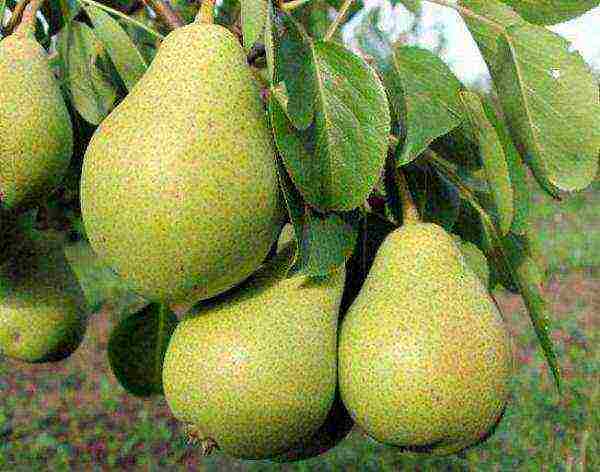 Pear variety Severyanka
Pear variety Severyanka
It was bred by breeders for the northern regions, hence its name. The variety is medium-sized, tree height from 3 to 6 m, with a dense crown and a pyramidal shape of the trunk... Young seedlings easily tolerate planting and quickly begin their growth, but the tree begins to bear fruit in 4-5 years. The leaves of the tree are light green, pointed in shape, with smooth edges. It blooms in early spring, has more than 6 petals in the inflorescence /
A variety with a high yield, the fruits are strewn with branches, every year the harvest becomes larger, in the same way, the tree bears fruit every year. The pear is large, up to 200 grams each fruit, they are formed into small clusters of 4-6 pears... At the beginning of ripening, they have green tones, and then they acquire yellowish-orange shades. The skin of the fruit is loose, sometimes rather rough. The taste is not inferior to other varieties, sweet, with juicy pulp, has a sour-tart taste and light aroma. But there are not many seeds in the pear, they are located in special chambers in the heart of the fruit. It tolerates winters, diseases and pests well enough, does not need special care.
Cathedral
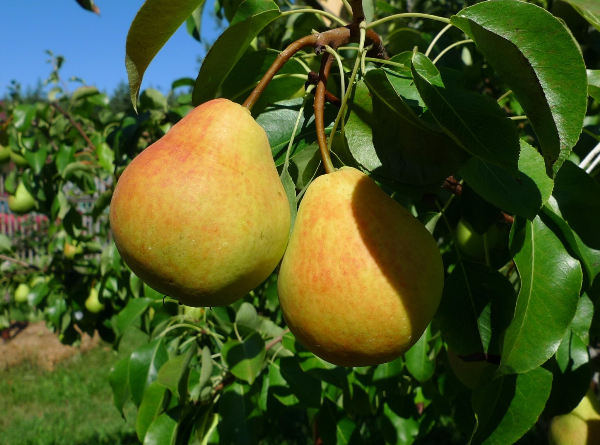 Rapid pear variety Cathedral
Rapid pear variety Cathedral
The same applies to summer, early-growing varieties. It was bred by crossing Lesnaya Krasavitsa and Duchess Bedro varieties. It grows mainly in the Central regions, but due to its resistance to frost, it grows easily in the regions of the North. The tree is medium-sized, from 4 m in height and above, with a wide and dense crown, the branches look up... The trunk is smooth, brown-gray. Young shoots are slightly drooping, reddish-brown in color, fruiting occurs on them. Leaves are green, smooth, medium in size.
Fruiting begins from the 6th year, the weight of a pear can exceed 130 grams. Ripening occurs in mid-August, the fruits remain on the tree for no more than 2 weeks, even less when plucked. Lemon-colored fruit with many splashes, change their shades closer from autumn to red-orange, which indicates full ripening of the fruit. The skin is thin, the flesh is creamy or white, sweet with a pleasant aroma, medium density. In the middle of the fruit are brown seeds, elongated.
Summer varieties of pears ripen by mid-summer, it is important to remember about their proper care. Summer pears love moisture in spring and especially during fruit formation. For the harvest to be faster, the tree needs annual pruning and feeding.
Winter
Saratovka
Obtained as a result of crossing the varieties Bere and Bergamot... They worked on a new variety at the Saratov State Agrarian University named after V.I. Vavilov. Refers to winter, plucked fruits under the right conditions can be stored until February!
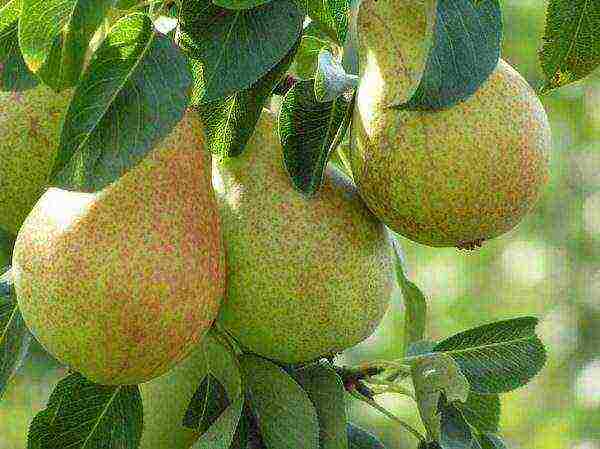 Frost-resistant pear variety Saratovka
Frost-resistant pear variety Saratovka
Saratovka is a medium-sized variety, the branches look straight up, the tree is more than 10 m high... The crown is dense, the trunk is brown-gray. Young leaves of light green color, oval, with smooth edges. By the fall, they are painted in dark green tones. The disadvantage is the dense crown, which needs proper pruning every year, otherwise, the tree reduces the amount of harvest, more energy is given to the formation of young shoots.
The yield is high, but the tree begins to bear fruit only in the 5th year. The fruits are sweet, firm, with a thick skin, lemon color, with a red-orange blush. It begins to ripen from mid-August, remains on the tree for a long time, until the end of September. The variety is winter-hardy, rarely exposed to diseases and pests, also tolerates long-term transportation, does not lose taste and external qualities.
Kondratyevka
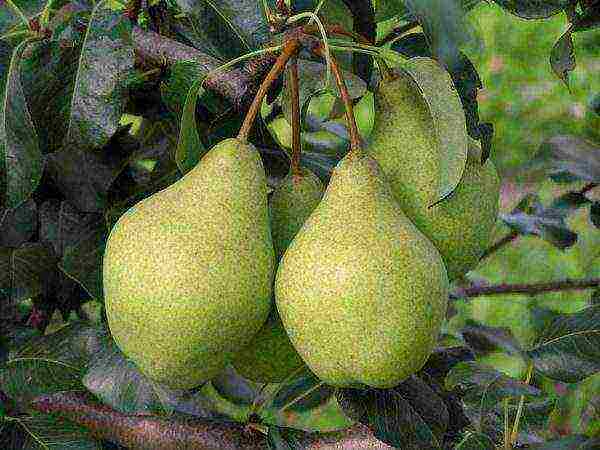 High-yielding pear variety Kondratyevka
High-yielding pear variety Kondratyevka
Winter pear variety, ripening occurs in early and mid-September. High yields start from 5 years after planting. Gives a bountiful harvest annually, the tree does not need rest. The mass of one pear reaches up to 230 grams... The fruits are sweet, juicy, with delicate pulp and spicy aroma. They have the correct pear-shaped shape and are attached to a thick curved stalk. They are green when ripe, slightly yellowish.
The tree itself is quite tall, 10-12 m in height, with a pyramidal trunk and slightly drooping branches. The variety differs from others in its slow growth, it mainly builds up green mass. But then it bears a large number of fruits. Survives severe cold quite easily, tolerant of various diseases and pests.
Pass-Krasan
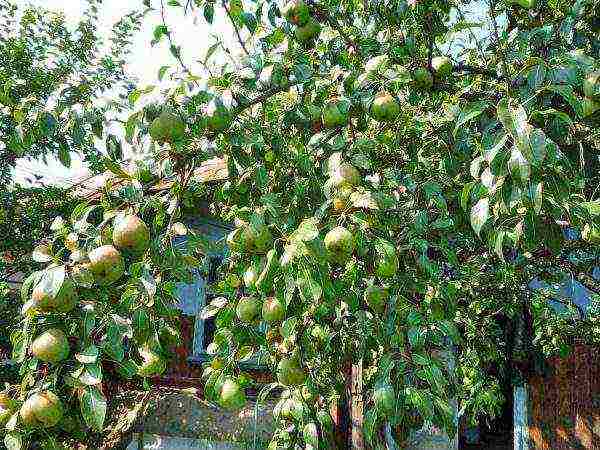 Pass-Krasan pear requires a lot of sunlight
Pass-Krasan pear requires a lot of sunlight
The same applies to winter pear varieties. Unlike other varieties that do not need special conditions, this hybrid requires increased attention. It prefers to grow only in sunny places, does not tolerate close proximity to other seedlings. From a lack of sunlight, its fruits become sour and do not reach the required size... He also loves moisture and well-fertilized soil. It is extremely cold and susceptible to many diseases.
But subject to all conditions, it gives large, juicy fruits with a slight sour taste. It bears fruit annually, does not require rest, but you should not expect a large amount of harvest from this variety. The mass of one pear can reach more than 200 grams, large pears are light green in color. The right time to harvest is mid to late October, by this time the fruits reach their optimal size and retain their taste. The advantage is the ability of the fruit to last until next spring.
In order for the variety to begin bearing fruit earlier, it is better to graft young seedlings on quince.
May Day
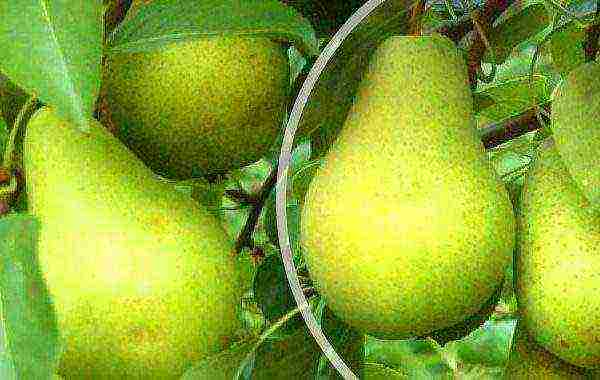 The fruits of the Pervomayskaya variety can last up to 8 months.
The fruits of the Pervomayskaya variety can last up to 8 months.
The result of crossing pears Daughter of Dawn and Late. This variety differs from others in the storage duration of the plucked fruits, up to 250 days! The pear is not demanding to care for, it is frost-resistant. She rarely gets sick, she doesn't care about many pests. The height of the tree is more than 10 m, with a spreading crown... Young shoots are rather thin, gray-brown, smooth. The leaves are round in shape, with smooth edges, slightly curved upwards.
Average fruit weight from 140 grams, have the correct shape, smooth and thin skin. During the summer, the fruits are green, towards autumn they acquire brown-red tones. Attached to the branches with a strong stalk, forming a cluster of 4-6 fruits. Sweet to taste, with a pleasant aroma, slightly tart, with white pulp, has an attractive appearance and taste. The variety has a high yield, but fruiting begins at 5-6 years.
Lyre
 Pear Lear
Pear Lear
Winter variety, with a high storage capacity of fruits, up to several months. A tree with a wide pyramidal trunk, light brown in color. Branches of medium thickness, most often gray, smooth. The leaves are elongated, smooth, of dark green shades.
Pear weight more than 200 grams, fruits of greenish tones, acquire a yellowish tint. They have an elongated fruit shape, with a smooth and thin skin. Harvesting can start from September. The pear is sweet to taste, with white juicy pulp. The yield is high, the tree does not need interruptions, but the harvest begins to appear only 4-5 years after planting. Resistant to diseases and pests, but has an average winter hardiness. Especially young seedlings need additional shelter for the winter.
Patriotic
 Winter variety of pears Patriotic
Winter variety of pears Patriotic
The result of the joint work of O.S. Kharchenko, A.V. Krasovsky and A.F. Mileshko. Blooms in late spring, white, rounded flowers with a light aroma. The tree itself is tall, more than 10 m, with a spreading crown, straight branches. The trunk is brown, smooth, regular in shape.
Fruits are large, light green in color, more yellow when fully ripe. Fruit weight up to 180 grams, has an attractive view for sale, also protects the view during long-term transportation. It is recommended to harvest the tree in early October, the fruits can be stored for several months in a cool place. It produces crops regularly, the tree rarely gets sick and is almost not damaged by insects. It is also frost-resistant and does not need special care, it tolerates scab and thermal burns of leaves. Ripe fruits are stored for several months.
In order for the pears to be stored longer, it is important for them to provide the necessary conditions. The fruit must not be damaged or dented when harvested. Also, the pear should be dry and wrapped in newspaper or paper. It is better to store in small boxes, in 2-3 rows. The room should not be damp, too hot and humid. The optimum storage temperature is + 8-14 degrees, in a dark place.
Late
Dessert Rossoshanskaya late
 Rossoshanskaya - pear with fruits of the autumn ripening period
Rossoshanskaya - pear with fruits of the autumn ripening period
Belongs to late varieties, ripening of fruits comes at the beginning of September. Dessert pear can be stored until January under proper storage conditions.... A hybrid, the result of crossing the varieties Lyubimitsa Klappa and Tonkovotka, bred in 1952. The tree is vigorous, more than 6 m in height, the seedling has a narrow pyramidal trunk, gray in color, an adult tree forms a wide and smooth trunk. The crown of the pear is branched, young branches are gray, looking up.
The fruit is large enough, weighing up to 180 grams, dark green tones at the beginning of ripening and brown-red shades by autumn. Fastened on branches of 6 pieces on thick stalks. Harvesting begins at 3 - 4 years, the yield percentage is high. Sweet to taste, with soft skin and juicy pulp.
Belarusian
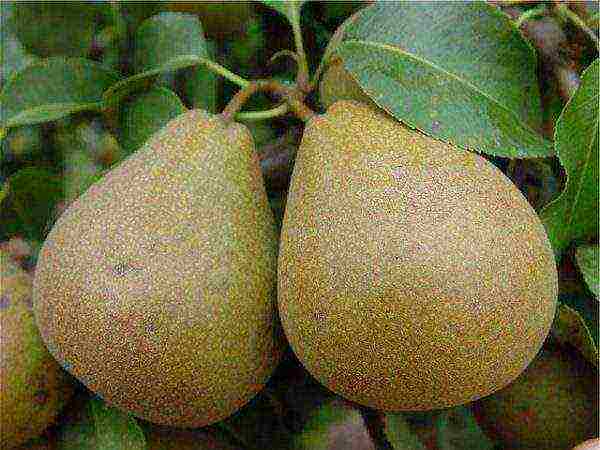 Pear Belarusian late
Pear Belarusian late
Bred in Belarus.The variety is late, ripening at the beginning of September. Small tree, no more than 3.5 m in height, branches look straight up, the crown is gray-brown, smooth. Leaves are light green in color, oblong in shape, with uneven edges. Flowering occurs at the beginning of spring, the inflorescences are white, with a pleasant aroma.
Fruits are dull, light green in color, changing to orange-red shades during the summer. The peel of the pear is rough, rather dense, with small black spots. The stalks are short, the pear is squeezed onto the branches in pairs. The pear tastes fleshy, with white flesh, juicy, has a slight sourness... The pear is winter-hardy, not subject to pests and diseases. Minus - it does not bear fruit every year, it needs rest.
Variety
Belarusian
is not always capable of pollinating on its own, therefore, in order to have a successful harvest, it is recommended to plant additional pollinated varieties on the site, for example,
Conference
or Bere loshitskaya.
Olivier de Serre
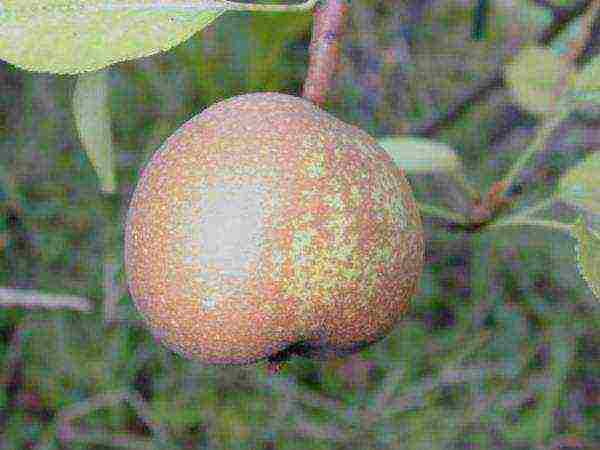 Olivier de Serre
Olivier de Serre
The work of a French breeder. The variety is quite capricious, requires special conditions for growth and careful care. The tree is medium-sized, the crown is compact, the branches are directed upwards. Crown of brownish shades, smooth, slightly flaky... During the summer, it forms many new branches, which reduces the yield, so it is important to remove excess branches in the fall. The leaves are shiny, dark green, rounded.
Fruits can weigh more than 400 grams... In appearance, the fruits are small, round in shape, with a thick skin. The whole fruit is covered with red spots, the surface is bumpy, uneven. The pear is sweet, with white fleshy pulp and a light pleasant aroma. The pear ripens by September and is stored harvested until spring. It is resistant to diseases, but in severe winters it needs additional shelter, otherwise the amount of harvest in the next year decreases.
Bere Ardanpon
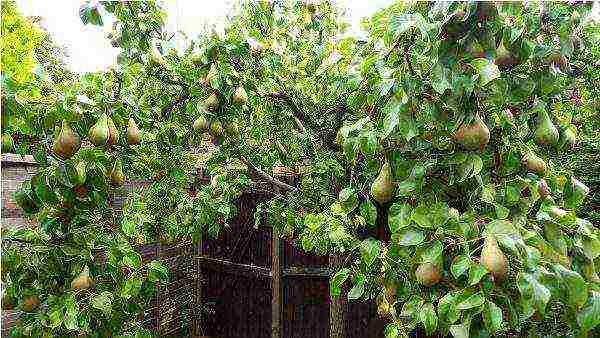 Pear of late ripening Bere Ardanpon
Pear of late ripening Bere Ardanpon
It was bred in Belgium by N. Ardanpon in 1759. This winter-hardy undersized hybrid requires special care. It prefers to grow in the sun, heat and well-moisturized soil - only under these conditions does the tree bear fruit. The tree is vigorous, with a dense crown of brownish-gray color... Young branches are thin, not lowered, The leaf blade is pointed, dark green, slightly pointed in shape. Blooms in early spring, with white fragrant inflorescences.
The fruits are large, green in mid-summer and reddish when fully ripe closer to autumn. A pear with a thin, smooth skin. This variety fell in love with gardeners because of its attractive presentation., which persists until cold weather. The pear is sweet to taste, with white, fleshy flesh. It tolerates winter firmly, but it is better to cover young seedlings.
Hera
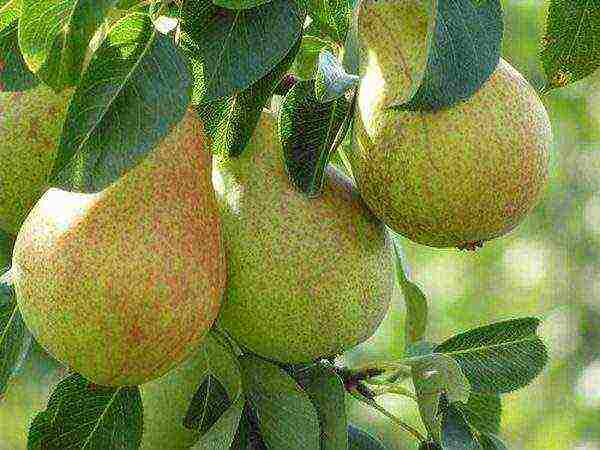 The Gera variety is famous for its large fruits.
The Gera variety is famous for its large fruits.
The same applies to winter varieties, which appeared as a result of crossing Reale Turin and Daughter of the Dawn. The variety is not particularly different from others, but because of its large fruits, it fell in love with gardeners. One pear can weigh up to 280 grams! In addition, the fruits have light green hues, which change to reddish during the ripening process. Not inferior in taste, pears are sweet, with fine-grained cream-colored pulp. They have a delicate, slightly sour taste, with a pleasant aroma.
The tree is medium-sized, no more than 6 m high, with spreading branches, crown, brownish color. Capable of producing a large amount of harvest annually, not picky about conditions and care. Plucked fruits can be stored for several months. In addition, the variety is quite resistant to diseases, is not afraid of insects, and is frost-resistant.
In ancient Greece, pear fruits were used as a remedy for nausea.
Miracle woman
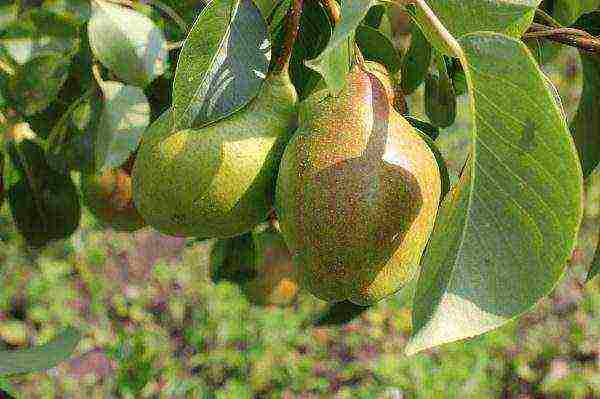 Pear Miracle
Pear Miracle
Another winter pear, a hybrid obtained by crossing the Daughter of Zarya and Talgar beauty varieties. Possesses excellent resistance to frost and disease... It has a pyramidal crown shape, no more than 5 m high.The branches are thin, looking up, gray-brown in color. The leaves are rounded, dark green in color, small light streaks are clearly visible. Blooms in early spring, with white fragrant inflorescences.
High yield variety, by weight one fruit from 140 to 210 grams, can remain on the tree for a long time and can be stored for a long time when assembled. Fruits are light green in color; towards autumn they become yellowish, slightly elongated. Sweet to taste, with fleshy pulp, have a delicate pleasant aroma.
Autumn
Autumn garden varieties differ from others in the long term storage in assembled form, they are not inferior in taste to summer or winter ones.
Veles
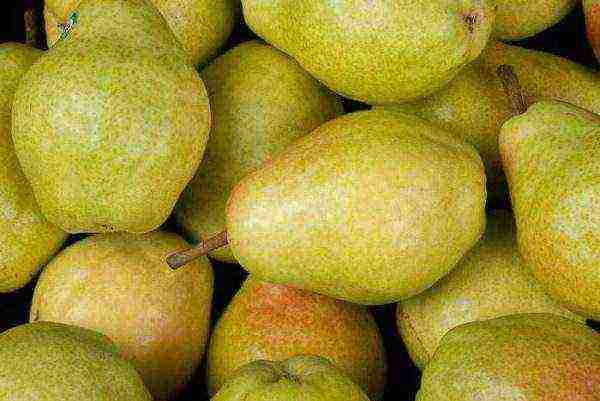 Veles pear variety
Veles pear variety
Autumn pear variety, one of the best. The fruits are large enough, the average weight of a pear is from 150 grams and above... Fruits are regular pear-shaped: narrow at the stalk and rounded at the bottom. On the branches they grow in small clusters, 3-4 pears each. The Veles pear ripens at the end of August, remains on the tree until October. It has a beautiful appearance, until the end of summer the fruits are dark green, and when ripe, they become red-orange tones. The taste is sweet, juicy, with fleshy pulp and thin skin.
The height of the tree is no more than 8 m, with drooping branches and a pyramidal shape of the trunk, gray-brown in color. Young branches are formed throughout the summer, which affects the amount of the harvest; it is recommended to prune in the fall. Resistant to frost, disease and pests.
Bere Moskovskaya
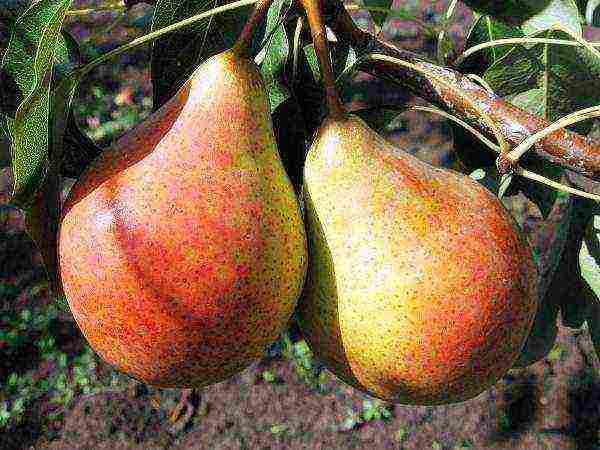 Bitter-tart pear variety Bere Moscowskaya
Bitter-tart pear variety Bere Moscowskaya
Frost-resistant, almost not exposed to diseases and pests. It appeared as a result of pollination of the Olga variety with pollen from the Lesnaya Krasavitsa and Lyubimitsa Klappa varieties. A tree no more than 6-8 m high... The crown of the pear is round, light brown in color. Young branches are rather thin, drooping, gray or brown in color. The leaf plate is dark green, rounded. The pear blooms in early spring.
Fruits are slightly bumpy, light green shades, there is a slight blush closer to autumn.It is best to remove fruits that are slightly green and firm in early autumn., so they keep better and stay longer, up to several months in a cool and dark place. If the pear tastes slightly tart, with sourness, it means that the pear does not have enough moisture. With proper care, the pear becomes sweet and fleshy, with a delicate white flesh. In general, this variety is not capricious when leaving.
Red-sided
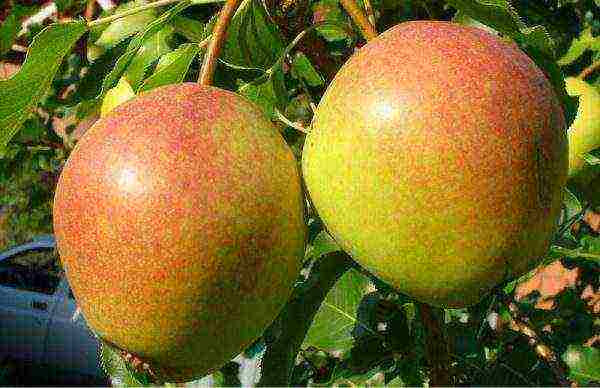 Pear variety Red-sided
Pear variety Red-sided
The misconception that this variety belongs to the winter, it is not, the variety is autumn ripening. It was obtained as a result of crossing the varieties Zheltoplodnaya and Tenderness. Resistant to diseases and pests, especially scab... It is frost-resistant, gives a good harvest from year to year. The crown is rounded, the branches are slightly drooping, brown-gray in color. Leaves are slightly pointed, light green shades in spring and dark green tones closer to autumn.
Does not require special care, can grow in small shade, under taller trees, but loves moisture. Fruits of medium size, weighing no more than 200 grams... Green pears change their shades to a raspberry blush as they ripen. Sweet to taste, with juicy fine-grained pulp and thin skin. Stick to branches, on short, curved stalks. The fruits are able to survive for a long time, both on the tree and in the assembled state, they are not afraid of transportation.
In memory of Yakovlev
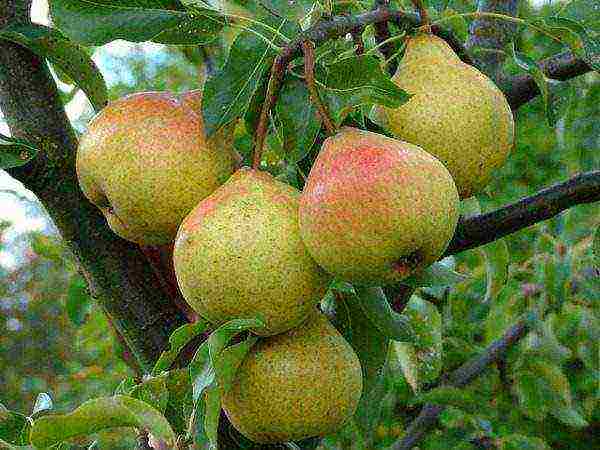 Pear variety of high winter hardiness in Memory of Yakovlev
Pear variety of high winter hardiness in Memory of Yakovlev
A medium-sized tree with a dense crown. The height of the tree does not exceed 1.5-2m, with a spherical crown. Young branches are thin, looking up, brown-gray in color with small thorns. The leaves are dark green, ovoid, with smooth edges. The harvest gives for 6-8 years... The Pamyati Yakovlev variety is popular among gardeners due to regular fruiting and unpretentious care.
Pears with smooth and thin skin, weighing no more than 200 grams. The fruits are collected in groups of 5-7 pears.The pear is sweet to taste, with juicy pulp and pleasant aroma. The fruits are golden in color, slightly reddish at the end of ripening. Full ripening of fruits occurs in mid-October.... The pear is stored on the tree for a long time, does not fall off, and in the assembled state it can lie for several months. High yield, which increases every year the tree grows. More than 30 kg of ripe pears are harvested from an adult tree per year. In addition, it is capable not only of self-pollination, but also pollinates other varieties of pears. It greatly simplifies the care of a pear that it is winter-hardy and unpretentious in care.
For the first time the word "pear" was mentioned in chronicles in the 12th century, and sounded like "hrusha". And all, because of the characteristic crunch, which was published when biting the fruit.
Muscovite
 Branch of pear Moskvichka with fruits
Branch of pear Moskvichka with fruits
Obtained as a result of pollination of one of the American Kieffer pear varieties. Possesses a standard shape, with a rather dense and spreading crown, light gray colors, which eventually changes shades to brown tones. Forms new curved shoots quickly. The foliage is light green in color, with an oval shape, slightly curved in the center. This variety gives a bountiful harvest in the southwestern regions. The first harvest is formed in 3-4 years.
Muscovites are medium-sized fruits, up to 150 grams. They have the correct pear-shaped shape. They have a greenish-yellow hue, which changes towards burgundy-crimson tones by the end of summer. The skin is thin, fleshy with a juicy pulp with a pronounced sweet-sour taste. It is recommended to pick pears when they are slightly underripe, because after lying in the room for a couple of days, the pear ripens and retains its taste. Under the right storage conditions, the fruits are able not to spoil for several months.... High resistance to scab and rot, also not afraid of frost.
Marble
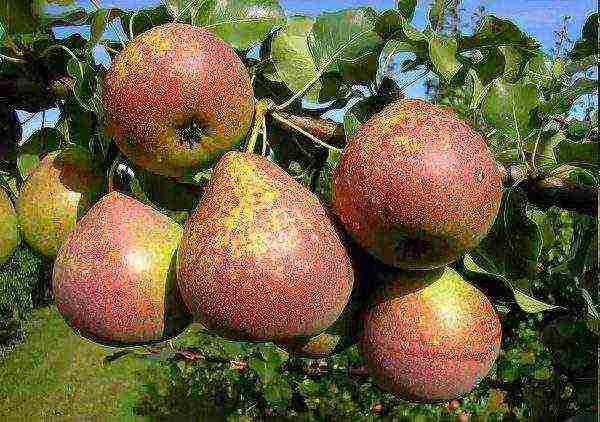 Marble pear fruits
Marble pear fruits
The fruit of the crossing of Bere Zimnaya Michurina and Lesnoy Krasavitsa varieties. The harvest of this variety ripens by the very beginning of autumn, the first fruits can be picked at the beginning of September. Differs from others in the height and density of the crown, the height of the tree is more than 8 m... Many light brown thin branches are formed every year, but pear shoots are extremely rare. Blooms in early spring with white fragrant inflorescences. The foliage is dark green in color.
The fruits are large, from 170 grams, with yellowish-green hues and a slight blush. The pear is also distinguished by the correct conical shape of the fruit. The pulp is coarse, tender, juicy. Rather dense rind, with small dots of a rusty color. The Marble variety, like other autumn pears, is frost-resistant, not afraid of diseases and pests. The tree begins to yield only 5 years, but the yield percentage is high, the pear is able to please with a large amount of harvest every year.
Pear for the Volga region and central Russia
Chizhovskaya
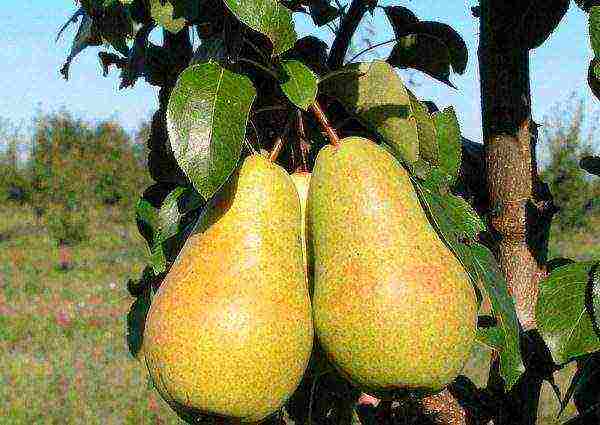 Winter-hardy pear Chizhovskaya
Winter-hardy pear Chizhovskaya
Olga and Lesnaya Krasavitsa were taken as the "parental" varieties, as a result of the long work of S.T. Chizhov and S.P. Potapov and the Chizhovskaya variety was bred. One of the popular self-pollinated varieties in the middle lane, especially in the Volga region and surrounding areas... The tree is no more than 3 m high, the young tree has a narrow crown, grayish shades. Older branches acquire a brownish color, branches look up, medium in thickness, slightly curved. Leaves are oval, dark green in color with smooth edges.
By themselves, the fruits weighing no more than 150 grams. At the beginning of summer, the pear is of light green tones, the fruit is quite hard, but closer to autumn it acquires yellow shades and becomes soft. In this state, the Chizhovskaya pear will not hang on the tree for a long time, therefore it is recommended to pluck it at the beginning of autumn. Green fruits can last for several weeks.... Sweet and fleshy on the palate, ripens in mid-August. They have a white, medium-grained pulp with a pleasant aroma. In addition, she inherited frost and disease resistance from her relatives.
The peculiarity of the variety is that the older the tree, the smaller the fruits. You can fight this with timely pruning.
Lada
 Pear Lada belongs to the early summer varieties
Pear Lada belongs to the early summer varieties
The result of crossing the varieties Lesnaya Krasavitsa and Olga, a variety suitable for planting in the middle lane. Differs in early maturity of fruits, you can taste fresh fruits already in the middle of summer... Lada is frost-resistant, is not susceptible to diseases and pests, and gives a rich harvest every year. A tree with a branchy crown, branches slightly drooping, looking down. The height of the tree is not more than 3 m, with a pyramidal trunk, closely gray in color. Leaves are shiny, smooth, dark green tones. It winters well enough even in the most severe winters, is resistant to diseases, partially self-fertile.
Medium-sized fruits, no more than 100 grams, light green tones with thin skin. Closer to ripening, the fruits give in yellow tones, become soft to the touch. It is important to take the moment to remove the fruits from the tree, otherwise they become soft, covered with rusty spots and fall off. The fruit is attached to the branches in pairs on short stalks. It tastes sweet, with a slight hint of sourness and can be stored for a long time when torn off, especially in a cool place.
Bessemyanka
 Pear Bessemyanka belongs to high-yielding varieties
Pear Bessemyanka belongs to high-yielding varieties
Popular and quite interesting for planting, especially spread in the Central regions, it also grows well in the middle lane. The tree is vigorous, the growth rate is fast, it yields consistently, does not need rest. The yield is high, more than 50 kg of fruits are harvested per year. The tree is more than 6 m high, with spreading and curved branches. Leaves are oval, dark green in color, with rounded edges. The variety is also resistant to frost, but prone to scab and other diseases.
Annually it pleases with a large amount of harvest, although the fruits are rather small, more like apples. Light green in color, firm when ripe, the fruits turn yellow and soft when ripe. Attached to branches, one fruit on short stalks. Ripening occurs at the end of summer, when the fruits become yellowish.... Does not last long on a tree, quickly falls off. In addition, it does not lie for long and in a torn form, no more than 2-3 weeks.
In Europe, until the moment when tobacco was introduced, crushed pear leaves were used for smoking.
Skorospelka from Michurinsk
 Pear Skorospelka from Michurinsk
Pear Skorospelka from Michurinsk
This variety breaks all records for the speed of fruit ripening. Bred by IV Michurin, as a result of crossing the varieties Citron de Carme and Bere Ligel. It belongs to the early varieties of pear, the harvest ripens by the middle of summer... It is a tall tree, the shape of the trunk is pyramidal, light brown in color.
Fruits no more than 90 grams, green in summer, acquire a yellow tint when fully ripe. Small fruits are offset by taste: sweet, juicy, this pear is loved not only by gardeners, but bees and birds. Therefore, it is better to collect them when they are a little hard, they are stored for no more than a week. The tree itself is winter-hardy, with a dense crown, resistant to diseases and pests.
Allegro
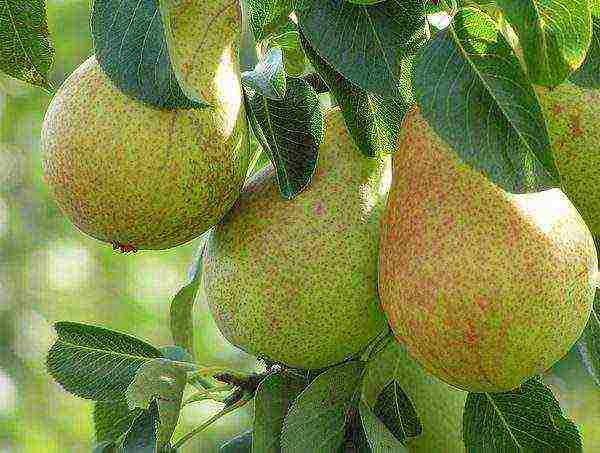 Pear variety for the middle Allegro strip
Pear variety for the middle Allegro strip
Bred thanks to artificial pollination of the Osennyaya Yakovleva variety. Another variety for the middle lane, which bears fruit annually, is unpretentious in care, resistant to disease and severe cold. Fruiting begins at the age of 3 years, over time, the fruits become larger in size. Medium-sized tree, more than 5 m high, with a lowered crown. The branches are curved, light gray, the leaves are slightly elongated, closely green in color.
A pear weighing from 120 grams with a thick skin, but juicy and sweet pulp, with a spicy aroma. Correct pear-shaped, the fruits are slightly elongated. They are attached to the branches with a thick stalk, grow on a branch one by one. Ripening occurs at the beginning of August., the fruits turn yellowish-red and become soft.The variety is not stored for a long time, ripe fruits hang on the tree for no more than 2 weeks, but when assembled they can lie for more than a month.
The middle zone of Russia has a special climate that is not suitable for growing all varieties of pears. There are pronounced hot summers, severe winters, and transitional periods with a lot of precipitation. Only those who “love” this weather can grow and bear fruit here, and proper care will ensure a greater pear yield.
Garden varieties for the Moscow region, description
Prominent or Bumpy
 Pear variety Bumpy
Pear variety Bumpy
A pear variety that has long been loved by the Moscow region. A tree no more than 5 m high, with a fairly spreading young crown, which subsequently takes on a pyramidal shape. During the summer, the tree forms many young branches, which must be cut in the fall, otherwise the fruits will become smaller. The leaf plate is elongated, with light streaks, dark green in color. Blooms in early spring, many white inflorescences with a pleasant aroma.
Fruiting begins in the 5th year, fruits of medium size, regular pear-shaped. The color is greenish-yellow during the summer, with a red tint closer to autumn. Fruits with thick skin and coarse white flesh... Sweet and juicy on the palate, with a pleasant aroma. When harvested, it can last for several months, but it is recommended to harvest the fruits in mid-August, when the fruits are quite hard and slightly underripe.
Tenderness
 Hybrid variety Tenderness
Hybrid variety Tenderness
The variety obtained as a result of crossing Tyoma and Lyubimitsa Klapp. A particularly large amount of crops gives in the Volga region, the middle lane and in the Moscow region... The tree is medium-sized, no more than 4 m in height, with a sparse crown. The branches are thin, light gray. The tree blooms in mid-spring, white, small inflorescences. The leaves are round, with smooth edges, smooth. Frost-resistant, capable of bearing fruit annually. It prefers to grow in sunny areas, is resistant to diseases, is not afraid of pests, so growing this variety will not be difficult.
Fruits are large, weighing more than 200 grams with a regular pear-shaped fruit... The pear tastes soft, juicy, coarse-grained with a pleasant aroma. Attached to branches with short stalks. In the middle of the fruit is a chamber with brown seeds. The fruits of this pear are preserved for a long time both on the tree and in the harvested form, especially at a temperature of 0 degrees.
The pear tree is not capable of deforming, which is why, for example, rulers for architects are made from it.
Fabulous
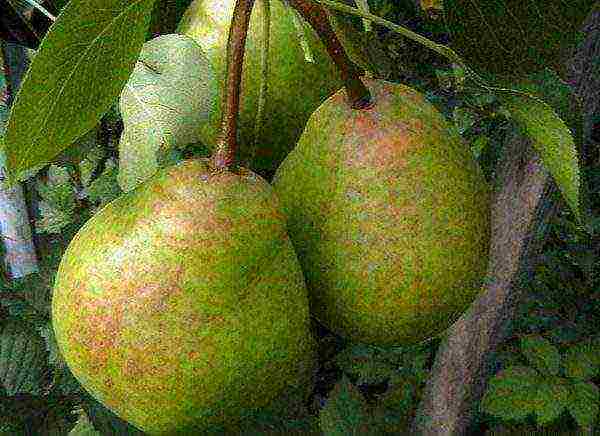 Pear Fairy is characterized as a tall and very productive variety.
Pear Fairy is characterized as a tall and very productive variety.
It got its name from the beautiful fruits. Obtained as a result of crossing the varieties Powislaya and Tenderness. The pear has a high yield, more than 30 kg of ripe fruits are harvested from one adult tree per season... The height of the tree reaches 4 m, the branches are dense, thin with a gray-brown crown. The leaf plate is smooth, rather small, of green shades, with small teeth along the edges.
When the pear ripens, it becomes yellow-reddish on one side and greenish on the other. Has the correct shape of the fruit, moreover one pear can weigh over 150 grams... The pulp of the pear is white, fleshy, medium-grained. In the center of the fruit are chambers with dark brown seeds. It tolerates diseases steadily, is not afraid of frost, seedlings easily take root in a new place.
Vera Yellow
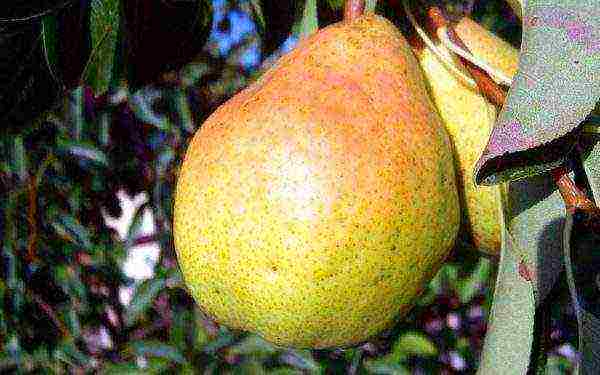 Vera Yellow
Vera Yellow
Another suitable variety for planting in the Moscow region. A tree with a height of more than 6 m, with a pyramidal shape of the trunk, with erect branches of a brown-brown color... Young leaves of light green tones, by autumn change color to dark green shades. Frost-resistant, does not need special care. The pear ripens in mid-September. It differs from others in that it has declines in yield, the fruits become smaller, but after a couple of years the pear again pleases with a large harvest.
Fruits have green hues throughout the summer, but change to yellow-orange colors closer to autumn. Fastens on short stalks, grows 2-3 pears in a bunch... To the taste, the pear is fragrant and fleshy, medium-grained pulp with a thin skin. Good storage capacity, especially in a cool place.
Elegant Efimova
 Variety Dressy Efimova
Variety Dressy Efimova
It turned out as a result of crossing the varieties Lyubimitsa Klappa and Tonkovotka. It grows well and gives a rich harvest in the Central Region, the Moscow Region and other nearby regions. High-yielding, winter-hardy, not subject to pests and diseases... The tree is tall, more than 5 m in height, with a dense crown, dark brown, pyramidal in shape. The leaves are small, dark green in color, with smooth edges.
Beautiful appearance of the fruit, red-orange tones are intertwined with green shades. But the fruits are small in size, weighing no more than 120 grams, regular, slightly distant shape. Soft, juicy pulp with a pleasant sweet aroma. The thin skin of the pear is prone to dark spots during the summer. Fruits ripen at the end of August, overripe quickly, so it is better to collect them a little hard, and it is recommended to store them in a cool and dark place.
Venus
 Pear venus
Pear venus
Another popular variety for planting, due to its winter hardiness and unpretentious care. Tree no more than 4m high, the crown is quite spreading, young branches are slightly lowered down, light brown in color. The variety blooms in early spring with white inflorescences with a sweet aroma. The variety also differs in high productivity, an adult tree is capable of producing more than 40 kg of harvest over the summer. Does not need rest, is able to bear fruit annually. In addition, the variety tolerates frosts, diseases and pests quite steadily.
The variety ripens in early autumn, the fruits are large, weighing up to 200 grams... Red-yellow in color, green tones when ripe. The taste is soft, juicy, slightly sour with a thin skin. They are stored for a long time both on the tree and when assembled.
Regardless of the specific variety, of which there are a great many today, the main thing in a pear is its taste and useful microelements, which are so abundant in ripe fruits. Winter, summer and autumn varieties differ from each other not only in taste, but also in the speed of fruit ripening., features of care, and the ability to preserve the fruit. Which variety to choose is up to you.
Winter varieties of pears are distinguished by excellent winter hardiness and a long shelf life of the crop. But there are not so many winter varieties with high performance. The winter varieties with the highest quality indicators that can be grown in both warm and cold regions will be described below.
What are the features of winter pear varieties?
Fruits from winter combs of pears are always harvested before they ripen. They are collected, then packaged and hidden for 1-2 months. During this time, the fruits are filled with juice, ripen and acquire their natural pleasant pear taste and aroma.
The taste of pears of this type is always very sweet, they have a large proportion of sugars and vitamins in their composition, and therefore are very useful for children and adults in fresh and processed form.
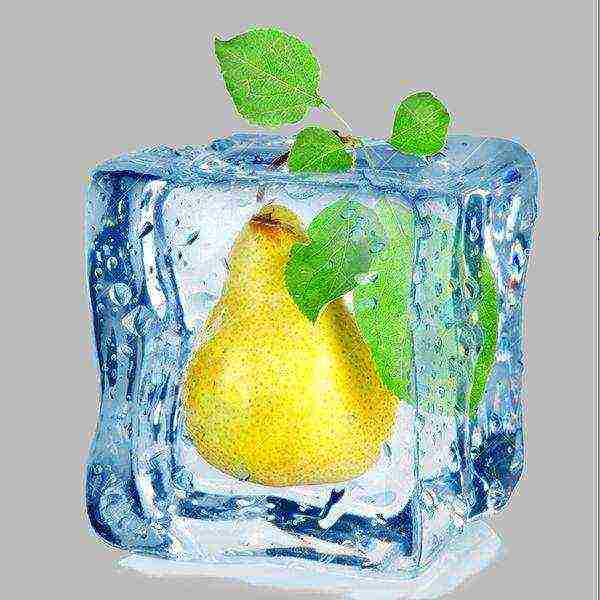
The shelf life of winter pears can be up to 6 months.
The shelf life of winter pears can be up to 6 months under good storage conditions. Trees are highly winter-hardy, but in the northernmost regions, they should still be insulated for the winter.
Often, winter pears are planted for fruit sale. After all, they, as a rule, are perfectly transported over any distance, and also have excellent commercial qualities.
The use is universal. Winter pears can be eaten fresh, canned, processed into juice, jam, frozen and dried.
Which varieties can withstand the coldest temperatures?
Winter pear varieties can withstand severe cold snaps, but frosts over -25 degrees are usually fatal for them.That is why pears are always insulated for the winter. And yet there are several varieties of pears that are very hardy in terms of low temperatures.
- "Nika" it has very good frost resistance. Colds down to -38 degrees are not terrible for her. Grows up to 4 meters. Fruits 150-200 g each with a smooth oily skin. The color is green, and after full ripening it is light yellow with red spots on the entire surface of the fruit. The pulp is fine-grained, sweet, oily consistency.
- "Hera" has excellent resistance to frost down to -38 degrees. The tree is of medium height, the crown is neat, compact. Fruiting begins from the 4th year of life. The yield reaches 40 kg / tree. It has an average resistance to disease and frost. Pears up to 250 g, reach technical maturity in mid-September. Fruits lie up to 5 months, then start to deteriorate.
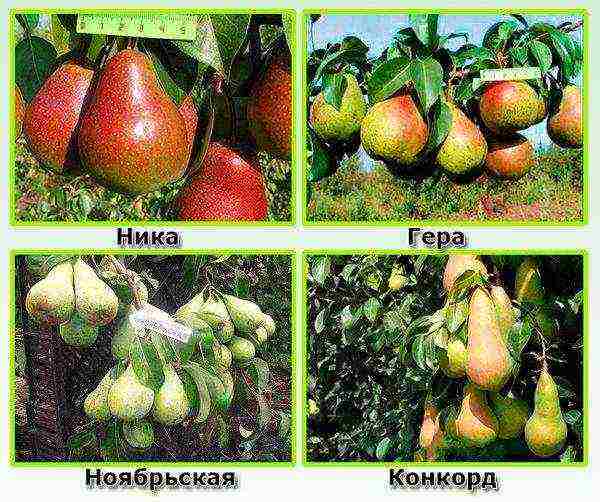
Which varieties can withstand the lowest temperatures
- "November" - winter variety of pears, not afraid of frosts down to -30 degrees. The tree grows up to 4-5 meters. The crown is spreading. Fruits are pear-shaped and vary in size from 70 to 350 g. Fruits are stored until April in good conditions.
- Concorde has similar characteristics with the "Conference" variety. It is harvested from late September or early October, while eating fruits can only be from mid-October. Fruits are stored until mid-February or March, then they begin to deteriorate. Withstand frosts down to -29.1 degrees Celsius. There is resistance to fungal diseases. The yield is high. Fruits up to 200 g, record weight - 350 g. Pear-shaped, elongated shape. The peel is oily, yellow with a red, blurred blush. The taste is sweet, the pulp is aromatic and juicy.
What are the most productive varieties of winter pears?
The most productive, winter varieties of pears allow you to collect from a tree from 100 kg of fruits or more per year. This amount allows you to make money selling them or preserve them for the winter.
- "Saint Germain" with good care, it can give up to 250 kg of pears from one tree per year. The fruits only slightly resemble a pear-shaped, they are longer, can be curved, weigh up to 220 g. The rind is thin, dense. The variety is prone to shedding, therefore it is worth picking the fruits immediately after ripening. The color is initially green, and after ripening, yellow with subcutaneous dots. The pulp is juicy, refreshing with a strong pleasant aroma.
- "Ardanpon" gives annually 180 kg of pears from one tree. Fruits weigh 170-220 g. Stored until January, have excellent transportability. Of the shortcomings, uneven ripening and rapid shedding of ripe fruits are noted. For winter, insulation is required, since frosts of more than -20 degrees may not survive.

What varieties of winter pears are the most productive
- "Curé" - a winter variety of pears, producing 100 kg of delicious fruits per season from each tree. Vigorous, has a developed, extensive crown. Fruiting from 3 years of age. Fruits up to 250 g are not stored for long. Already 2 months after full maturation, they begin to gradually deteriorate. The taste is normal, but consumers note that it is too bland, without a pronounced pear aroma.
- "Parisian" has a high yield - up to 100 kg per tree. Resistant to frost, bears fruit for 4 years after planting. The tree is of medium height. Fruits up to 180 grams, reach technical ripeness in October and are stored until the end of winter. It has good transportability, does not crumble and has an amicable ripening. Requires annual treatment for diseases and pests.
- "Dekanka Krasnokutskaya" yields up to 100 kg of fruits per year from a tree. Trees grow up to 3 meters. They should be insulated for the winter, since they cannot withstand severe frosts. Pears are yellow-green, with a shortened pear-shaped shape. The pulp is juicy, sweet when fully ripe. Harvested in September, eaten in a month, and it is stored until the end of February.
Which varieties are best kept?
Winter varieties of pears differ in that they are stored for a very long time, but which varieties can lie until the beginning of spring or even until May?
- "Pervomayskaya" the pear can be stored for up to 8 months! Fruits of 150 grams, there are also up to 200 g. The shape is correct, the consistency of the pulp is buttermilk, the taste is juicy, sweet with sourness and light astringency. The color of the fruit is green, and after ripening it is yellowish with reddish-brown spots all over the surface. It has a strong aroma. Fungal diseases are not affected.
- "Zest of Crimea" has very stable fruits. Under normal conditions, they lie for 7 months without changing the taste and quality of the pulp. Trees bear fruit since 4 years. The yield is high. Pears can grow up to 400 grams, the shape is typical, pear-shaped, golden color. The taste is pleasant, the pulp is tender, sweet and sour.

Which varieties are best kept
- "Belarusian late" stored for up to 6 months. Has a stable high yield. This winter variety of pears ripens from mid-September. The fruits are 120 g each. The color of technical ripeness, when harvested, is green with a brown blush. A month after harvest, they acquire a yellow color with a blurred red flank. The pulp is juicy, fine-grained, there is sourness, but the main taste is sweet. The tree grows up to 4 meters, begins to bear fruit in 3 years.
- "Winter kubarevnaya" can lie 5-6 months after collection. The fruits are pear-shaped, with clear outlines, up to 200 g with a dense, coarse green skin and a brown blush. After fully ripening, the pulp becomes white, juicy and sweet with a small amount of acid. The tree grows up to 4 meters, the main disadvantages are late fruiting - 6-7 years.
VIDEO - November pear
Among the huge variety of pears, winter varieties stand out for their long shelf life, frost resistance and suitability for conservation. We have selected winter varieties recognized by experts as the best in terms of yield.
The pear is more sensitive to frost than the apple tree, so breeders for a long time could not get truly winter-hardy varieties. But now this problem has been resolved. Even residents of the northern regions can find excellent pear varieties for themselves, which will be stored for several weeks, and sometimes months!
Why late varieties of pears are good
Among inexperienced gardeners, there is an opinion that winter pears are tasteless and hard. However, many people forget that the dates of removable and consumer maturity in winter pear varieties do not coincide. The removed fruits must lie down for some time before acquiring their characteristic taste characteristics.
The fruits of winter pears are distinguished by tender and sweet pulp, they contain a large amount of vitamins and useful biologically active substances.
The indisputable advantages of winter pear varieties are:
- long shelf life (5-6 months);
- resistance of the tree to severe frosts;
- rich taste and aroma that pears acquire in the ripening process;
- attractive fruit appearance;
- they can be preserved.
According to the shelf life, pears are divided into three groups:
- early winter (Kure, Nart, Noyabrskaya, Elena, Zolotovorotskaya, etc.) - stored in the refrigerator until mid-January - early February;
- winter (Saratovka, Kondratyevka, Pass-Crassan, Olivier de Serre, Kirghiz winter, etc.) - stored in the refrigerator until the end of March;
- late winter (Tikhonovka, Emerald, Zest of Crimea, Maria, Winter Dekanka, etc.) - stored until early May.
We have selected varieties suitable for most climatic zones, thanks to their winter hardiness and excellent taste.
Belarusian late
A variety that won't let you down. Fruits of the correct wide-pear-shaped shape. In the period of removable maturity (mid-September), these pears are green with light brown spots, subsequently a red-brown blush appears on them. During storage, the color of the fruit changes to yellow with orange spots and a raspberry blush. The pulp of Belorusskaya late is juicy, white, fine-grained, has a pleasant, sweet, slightly sour taste.Advantages of the variety: winter hardiness, high yield, excellent keeping quality.
| Entering fruiting | Tree height (m) | Fruit weight (g) | Harvest | Shelf life (days) | |
|
3-4 years |
Up to 4 |
110-120 |
Mid - end of September |
150-180 | |
Bere winter Michurina
In terms of yield, the trees of this variety, bred by IV Michurin himself, surpass many other varieties. Fruits are medium in size, classic pear-shaped, with slight asymmetry. The main color of pears is light green, subsequently a reddish blush appears on the skin. During storage, pears turn yellow, the blush becomes larger. The pulp of the fruit is white, juicy and firm, with a slight tart aftertaste. The variety is resistant to scab, but its winter hardiness is average.
| Entering fruiting | Tree height (m) | Fruit weight (g) | Harvest | Shelf life (days) | |
|
For 6-7 years |
4-5 |
120-140 |
End of September |
130-150 | |
Far East
An early winter fruitful variety of pears. Fruits are small, regular pear-shaped, yellow, with numerous brown blotches. Their flesh is white, juicy, with dense, hard lumps. Pears are delicious, sweet and sour, with a pleasant aroma and aftertaste (just let them sit). The advantages of the variety include high winter hardiness and absolute resistance to scab.
| Entering fruiting | Tree height (m) | Fruit weight (g) | Harvest | Shelf life (days) | |
|
For 4-5 years |
2-3 |
80-100 |
Third decade of September |
50-70 | |
Winter kubarevidny
The memorable name is associated with the fruits of a cuboid shape (rounded cube). Their skin is dense and rough, green in color, sometimes with a dull raspberry blush. During storage, small gray subcutaneous dots appear on it. The pulp is white, very juicy, with a rich sweet and sour taste. The variety is distinguished by good frost resistance and insensitivity to scab. In addition, the Winter Kubarevidnaya annually pleases with a plentiful harvest, which is stored for up to 6 months.
| Entering fruiting | Tree height (m) | Fruit weight (g) | Harvest | Shelf life (days) | |
|
For 6-7 years |
3-4 |
180-200 |
Early October |
150-180 | |
Nika
"Goddess of Victory" among pears. The tree is medium-sized, the fruits are truncated-conical, rounded. The skin is smooth and oily, with a waxy coating. The main color of the fruit is greenish with red spots. In the period of consumer maturity, pears become light yellow, brownish-red spots cover the entire surface of the fruit. The pulp is creamy, medium density, fine-grained, buttery consistency. The taste is sweet with sourness. The variety is characterized by high winter hardiness, susceptible to scab diseases and entomosporiosis.
| Entering fruiting | Tree height (m) | Fruit weight (g) | Harvest | Shelf life (days) | |
|
For 5-6 years |
3-4 |
150-200 |
Second decade of September |
90-100 | |
May Day
Winter variety with a festive name. Fruits of regular shape with oily skin and waxy bloom. The main color of pears is green, with a pink blush on the side facing the sun. During the storage period, the fruits do not get sick (as it might seem), they just change color to greenish-yellow with a brown blush. The pulp is creamy, medium density, semi-oily, juicy, very aromatic. The taste is sweet and sour, with an implicit astringency. The variety is winter-hardy and absolutely resistant to fungal diseases.
| Entering fruiting | Tree height (m) | Fruit weight (g) | Harvest | Shelf life (days) | |
|
For 5-6 years |
3-4 |
150-220 |
Second decade of September |
220-250 | |
Saratovka
Variety - "middle peasant", which belongs to the late autumn-early winter. The fruits are elongated pear-shaped, with a smooth, oily skin and small dots on it. The main color of pears is greenish-yellow; as they ripen, they acquire a bright golden-yellow color. The pulp is white, tender and soft with a pronounced sweet and sour taste, without astringency, very juicy. The pear tolerates winter well, but drought is worse. The variety is immune to pear scab and powdery mildew.
| Entering fruiting | Tree height (m) | Fruit weight (g) | Harvest | Shelf life (days) | |
|
For 4-5 years |
4-5 |
120-140 |
End of September |
120-150 | |
Saint Germain
The variety has been known since the 19th century under the name Good Louise. Despite its Western European origin, it is grown in Central Asia and other southern regions and temperate zones. The fruits are large, oblong-ovoid in shape. The skin is thin, dense and firm, but sensitive to impact and damage, so fallen pears quickly rot. As it ripens, the pear changes color from light green to yellow. Rust points are scattered in large numbers on the surface of the fruit, sometimes they can form a continuous mesh or large spots (this is normal). The pulp is greenish-white, of medium density, with a fragrant aroma and refreshing taste, juicy and sweet.
| Entering fruiting | Tree height (m) | Fruit weight (g) | Harvest | Shelf life (days) | |
|
For 4-6 years |
Up to 6-7 |
180-220 |
End of September |
120-150 | |
January
Fresh treats for the New Year's table. Fruits are medium in size, broadly pear-shaped. The skin is smooth, rough, matte. The main color of the pear is greenish; during the period of consumer maturity, the fruits acquire a yellowish tint. On the sunlit side of the pear, over time, a brown tan appears, turning into a reddish blush. The subcutaneous dots are green, well visible. The pulp is white with a greenish tint, juicy and sweet. The variety is quite resistant to scab and severe frosts.
| Entering fruiting | Tree height (m) | Fruit weight (g) | Harvest | Shelf life (days) | |
|
3-4 years |
3-4 |
130-150 |
Mid - end of September |
120-150 | |
Winter varieties of pears are distinguished by high yields. And their fruits can be stored almost until the new harvest, becoming more tasty and aromatic over time. Set aside some space in your garden for them and you can enjoy your own delicious pears all year round.
Pear varieties are known to be subdivided into winter, autumn and summer varieties. Each category differs not only in terms of ripening, taste, but also in terms of storage of fruits... So, which varieties can be attributed to winter, and which ripen in summer, see the description below.
Summer pear varieties
August dew
 Pear August dew
Pear August dew
The undisputed favorite among summer pear varieties is August Dew, the result of a crossing of Tenderness and Triumph Pakgam varieties. The tree is rather low, less than 10 m in height, the bark is gray, smooth, the buds quickly "wake up" after winter. Branches are spreading, slightly drooping, curved. The leaves are oblong, medium in size, dark green in color. Fruits are of medium size, ripen in mid-summer. The taste is quite sweet, juicy, with white pulp and delicate skin.
Unfortunately, it is not suitable for long storage, the pear quickly turns brown and disappears. It is itself resistant to diseases and pests, easily tolerates winters, bears fruit every year, increasing the number of fruits. The disadvantage of this variety is that it constantly needs to trim the crown, because of this, the fruits become smaller.
Bere Giffard
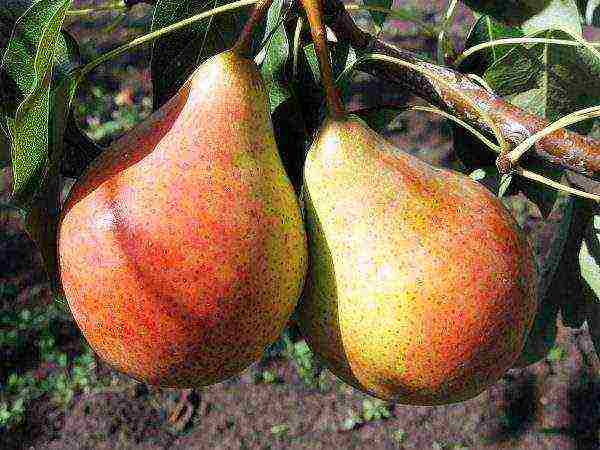 Pear variety Bere Giffard
Pear variety Bere Giffard
The same applies to summer varieties of pears. They differ from other varieties with their "ruddy" fruits, red-orange tones on one side of the pear, and light green shades on the other side. Formed on a branch in bundles, from 2 to 6 pieces, and keep that way until fully ripe. Due to the high yield, additional supports are often required, otherwise the branches may break under the weight of the fruit.
The fruits are tender, have a sweet taste, juicy, with white flesh. The tree reaches more than 10 m in height, a sparse crown, branches are slightly drooping and thin. The crown is brown, peels off. The leaf plate is dark green, oblong, with smooth edges. The variety does not tolerate severe winters, therefore, young seedlings require shelter. Fruits are poorly preserved when plucked, no more than a week.
Victoria
 Winter-hardy pear variety Victoria
Winter-hardy pear variety Victoria
This variety is distinguished by its winter hardiness, is not afraid of drought and is rarely exposed to diseases and pests. It appeared as a result of crossing the varieties Bere Bosk and Tolstobezhka. Medium tree, 8-10 m, with a dense crown, has a pyramidal trunk shape, branches are long and thin. The variety is characterized by late vegetation, flowering. Productivity is high, more than 150 kg of harvest is harvested from an adult tree per year.
The pear begins to ripen in the second half of August, reaching its peak of maturity only by the middle of September. The fruits have a regular pear-shaped shape, with a smooth and thin skin.... The pear tastes sweet, with juicy pulp, and has a pleasant aroma. It is good to make jam and jams from this variety. But the pear is stored for a short time, in a torn form it does not deteriorate for about 3 days, it can hang on the tree for no more than a week, then it falls off.
Victoria is only half pollinated. To increase yields, it is recommended to plant it next to varieties such as Bere Dumont,
Williams
Red.
Duchess
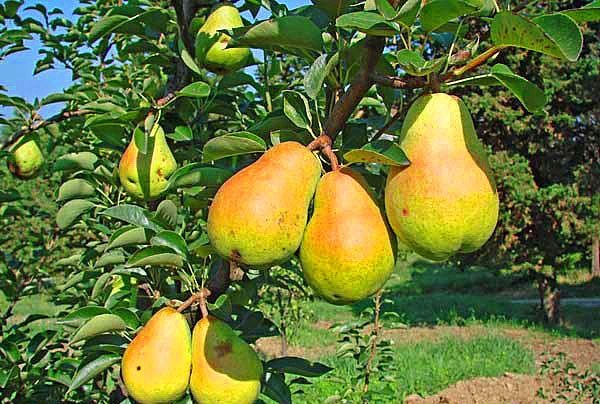 Summer pear variety Duchess
Summer pear variety Duchess
The name of the variety, translated as Duchess, was bred by an English breeder in Wheeler. The tree is not tall, 6-7 m, with a dense crown, branches are spreading, thin... The crown is a light brown tree, smooth.
Fruits begin to ripen in mid-August, the fruits are bright yellow. On average, one pear can weigh more than 150 g, are located on the branches singly or in groups of 4-6 pears. Stored up to 40 days on a tree and no more than 2 weeks when torn off... The fruit tastes juicy, sweet, with a thin skin and delicate aroma. The taste contains light notes of nutmeg and spices. The variety is frost-hardy, not afraid of cold weather. It is also not affected by scab, but copperhead and aphids are on the tree very often.
How can you tell if summer pears can be picked from the tree? Firstly, if fallen fruits have already begun to appear on the ground, then the harvest is ready. Secondly, it can be determined by the color of the fruit, the ripe fruits become yellowish. Thirdly, if the pear has become soft to the touch, then it can be safely removed from the tree.
Severyanka
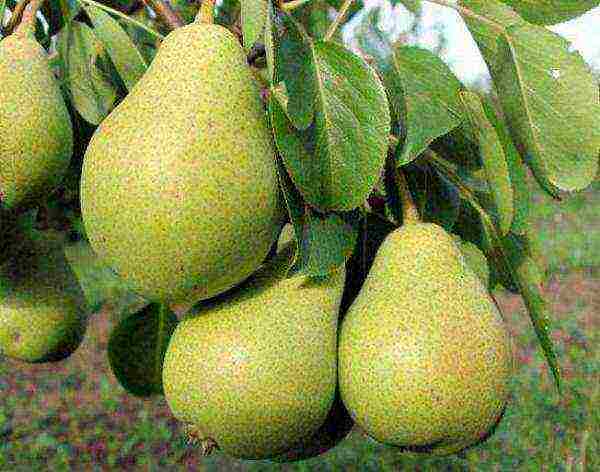 Pear variety Severyanka
Pear variety Severyanka
It was bred by breeders for the northern regions, hence its name. The variety is medium-sized, tree height from 3 to 6 m, with a dense crown and a pyramidal shape of the trunk... Young seedlings easily tolerate planting and quickly begin their growth, but the tree begins to bear fruit in 4-5 years. The leaves of the tree are light green, pointed in shape, with smooth edges. It blooms in early spring, has more than 6 petals in the inflorescence /
A variety with a high yield, the fruits are strewn with branches, every year the harvest becomes larger, in the same way, the tree bears fruit every year. The pear is large, up to 200 grams each fruit, they are formed into small clusters of 4-6 pears... At the beginning of ripening, they have green tones, and then they acquire yellowish-orange shades. The skin of the fruit is loose, sometimes rather rough. The taste is not inferior to other varieties, sweet, with juicy pulp, has a sour-tart taste and light aroma. But there are not many seeds in the pear, they are located in special chambers in the heart of the fruit. It tolerates winters, diseases and pests well enough, does not need special care.
Cathedral
 Rapid pear variety Cathedral
Rapid pear variety Cathedral
The same applies to summer, early-growing varieties. It was bred by crossing Lesnaya Krasavitsa and Duchess Bedro varieties. It grows mainly in the Central regions, but due to its resistance to frost, it grows easily in the regions of the North. The tree is medium-sized, from 4 m in height and above, with a wide and dense crown, the branches look up... The trunk is smooth, brown-gray. Young shoots are slightly drooping, reddish-brown in color, fruiting occurs on them. Leaves are green, smooth, medium in size.
Fruiting begins from the 6th year, the weight of a pear can exceed 130 grams.Ripening occurs in mid-August, the fruits remain on the tree for no more than 2 weeks, even less when plucked. Lemon-colored fruit with many splashes, change their shades closer from autumn to red-orange, which indicates full ripening of the fruit. The skin is thin, the flesh is creamy or white, sweet with a pleasant aroma, medium density. In the middle of the fruit are brown seeds, elongated.
Summer varieties of pears ripen by mid-summer, it is important to remember about their proper care. Summer pears love moisture in spring and especially during fruit formation. For the harvest to be faster, the tree needs annual pruning and feeding.
Winter
Saratovka
Obtained as a result of crossing the varieties Bere and Bergamot... They worked on a new variety at the Saratov State Agrarian University named after V.I. Vavilov. Refers to winter, plucked fruits under the right conditions can be stored until February!
 Frost-resistant pear variety Saratovka
Frost-resistant pear variety Saratovka
Saratovka is a medium-sized variety, the branches look straight up, the tree is more than 10 m high... The crown is dense, the trunk is brown-gray. Young leaves of light green color, oval, with smooth edges. By autumn, they are painted in dark green tones. The disadvantage is the dense crown, which needs proper pruning every year, otherwise, the tree reduces the amount of harvest, more energy is given to the formation of young shoots.
The yield is high, but the tree begins to bear fruit only in the 5th year. The fruits are sweet, firm, with a thick skin, lemon color, with a red-orange blush. It begins to ripen from mid-August, remains on the tree for a long time, until the end of September. The variety is winter-hardy, rarely exposed to diseases and pests, also tolerates long-term transportation, does not lose taste and external qualities.
Kondratyevka
 High-yielding pear variety Kondratyevka
High-yielding pear variety Kondratyevka
Winter pear variety, ripening occurs in early and mid-September. High yields start from 5 years after planting. Gives a bountiful harvest annually, the tree does not need rest. The mass of one pear reaches up to 230 grams... The fruits are sweet, juicy, with delicate pulp and spicy aroma. They have the correct pear-shaped shape and are attached to a thick curved stalk. They are green when ripe, slightly yellowish.
The tree itself is quite tall, 10-12 m in height, with a pyramidal trunk and slightly drooping branches. The variety differs from others in its slow growth, it mainly builds up green mass. But then it bears a large number of fruits. Survives severe cold quite easily, tolerant of various diseases and pests.
Pass-Krasan
 Pass-Krasan pear requires a lot of sunlight
Pass-Krasan pear requires a lot of sunlight
The same applies to winter pear varieties. Unlike other varieties that do not need special conditions, this hybrid requires increased attention. Prefers to grow only in sunny places, does not tolerate close proximity to other seedlings. From a lack of sunlight, its fruits become sour and do not reach the required size... He also loves moisture and well-fertilized soil. It is extremely cold and susceptible to many diseases.
But subject to all conditions, it gives large, juicy fruits with a slight sour taste. It bears fruit annually, does not require rest, but you should not expect a large amount of harvest from this variety. The mass of one pear can reach more than 200 grams, large pears are light green in color. The right time to harvest is mid to late October, by this time the fruits reach their optimal size and retain their taste. The advantage is the ability of the fruit to last until next spring.
In order for the variety to begin bearing fruit earlier, it is better to graft young seedlings on quince.
May Day
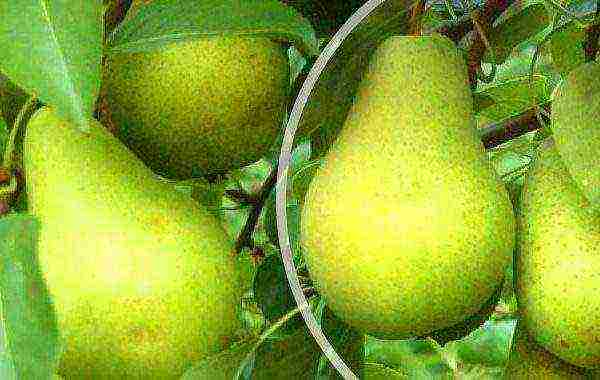 The fruits of the Pervomayskaya variety can last up to 8 months.
The fruits of the Pervomayskaya variety can last up to 8 months.
The result of crossing pears Daughter of Dawn and Late.This variety differs from others in the storage duration of the plucked fruits, up to 250 days! The pear is not demanding to care for, it is frost-resistant. She rarely gets sick, she doesn't care about many pests. The height of the tree is more than 10 m, with a spreading crown... Young shoots are rather thin, gray-brown, smooth. The leaves are round in shape, with smooth edges, slightly curved upwards.
Average fruit weight from 140 grams, have the correct shape, smooth and thin skin. During the summer, the fruits are green, towards autumn they acquire brown-red tones. Attached to branches with a strong stalk, forming a cluster of 4-6 fruits. Sweet to taste, with a pleasant aroma, slightly tart, with white pulp, has an attractive appearance and taste. The variety has a high yield, but fruiting begins at 5-6 years.
Lyre
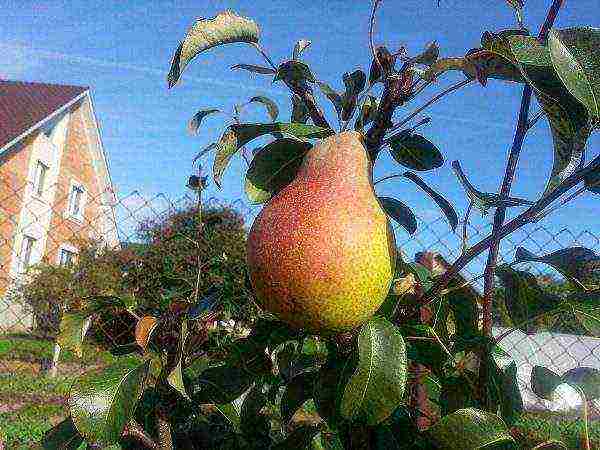 Pear Lear
Pear Lear
Winter variety, with a high storage capacity of fruits, up to several months. A tree with a wide pyramidal trunk, light brown in color. Branches of medium thickness, most often gray, smooth. Leaves are elongated, smooth, dark green shades.
Pear mass more than 200 grams, fruits of greenish tones, acquire a yellowish tint. They have an elongated fruit shape, with a smooth and thin skin. Harvesting can start from September. The pear is sweet to taste, with white juicy pulp. The yield is high, the tree does not need interruptions, but the harvest begins to appear only 4-5 years after planting. Resistant to diseases and pests, but has an average winter hardiness. Especially young seedlings need additional shelter for the winter.
Patriotic
 Winter pear variety Patriotic
Winter pear variety Patriotic
The result of the joint work of O.S. Kharchenko, A.V. Krasovsky and A.F. Mileshko. Blooms in late spring, white rounded flowers with a light aroma. The tree itself is tall, more than 10 m, with a spreading crown, straight branches. The trunk is brown, smooth, regular in shape.
Fruits are large, light green in color, more yellow when fully ripe. Fruit weight up to 180 grams, has an attractive view for sale, also protects the view during long-term transportation. It is recommended to harvest the tree in early October, the fruits can be stored for several months in a cool place. It produces crops regularly, the tree rarely gets sick and is almost not damaged by insects. It is also frost-resistant and does not need special care, it tolerates scab and thermal burns of leaves. Ripe fruits are stored for several months.
For pears to be stored longer, it is important for them to provide the necessary conditions. The fruit must not be damaged or dented when harvested. Also, the pear should be dry and wrapped in newspaper or paper. It is better to store in small boxes, in 2-3 rows. The room should not be damp, too hot and humid. The optimum storage temperature is + 8-14 degrees, in a dark place.
Late
Dessert Rossoshanskaya late
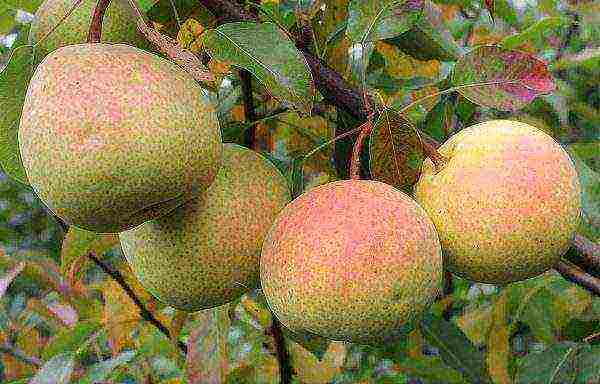 Rossoshanskaya - pear with fruits of autumn ripening period
Rossoshanskaya - pear with fruits of autumn ripening period
Belongs to late varieties, ripening of fruits comes at the beginning of September. Dessert pear can be stored until January under proper storage conditions.... A hybrid, the result of crossing the varieties Lyubimitsa Klappa and Tonkovotka, bred in 1952. The tree is vigorous, more than 6 m in height, the seedling has a narrow pyramidal trunk, gray in color, an adult tree forms a wide and smooth trunk. The crown of the pear is branched, young branches are gray, looking up.
The fruit is large enough, weighing up to 180 grams, dark green tones at the beginning of ripening and brown-red shades by autumn. Fastened on branches of 6 pieces on thick stalks. Harvesting begins at 3 - 4 years, the yield percentage is high. Sweet to taste, with soft skin and juicy pulp.
Belarusian
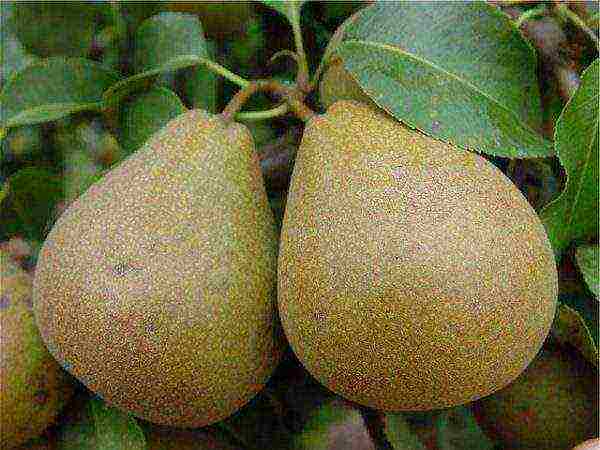 Pear Belarusian late
Pear Belarusian late
Bred in Belarus. The variety is late, ripening at the beginning of September. Small tree, no more than 3.5 m in height, branches look straight up, the crown is gray-brown, smooth. Leaves are light green, oblong in shape, with uneven edges. Flowering occurs at the beginning of spring, the inflorescences are white, with a pleasant aroma.
Fruits are dull, light green in color, changing to orange-red shades during the summer. The peel of the pear is rough, rather dense, with small black spots. The stalks are short, the pear is squeezed onto the branches in pairs. The pear tastes fleshy, with white flesh, juicy, has a slight sourness... The pear is winter-hardy, not subject to pests and diseases. Minus - it does not bear fruit every year, it needs rest.
Variety
Belarusian
it is not always capable of pollinating on its own, therefore, in order to have a successful harvest, it is recommended to plant additional pollinated varieties on the site, for example,
Conference
or Bere loshitskaya.
Olivier de Serre
 Olivier de Serre
Olivier de Serre
The work of a French breeder. The variety is quite capricious, requires special conditions for growth and careful care. The tree is medium-sized, the crown is compact, the branches are directed upwards. Crown of brownish shades, smooth, slightly flaky... During the summer, it forms many new branches, which reduces the yield, so it is important to remove excess branches in the fall. The leaves are shiny, dark green, rounded.
Fruits can weigh more than 400 grams... In appearance, the fruits are small, round in shape, with a thick skin. The whole fruit is covered with red spots, the surface is bumpy, uneven. The pear is sweet, with white fleshy pulp and a light pleasant aroma. The pear ripens by September and is stored harvested until spring. It is resistant to diseases, but in severe winters it needs additional shelter, otherwise the amount of harvest in the next year decreases.
Bere Ardanpon
 Pear of late ripening Bere Ardanpon
Pear of late ripening Bere Ardanpon
It was bred in Belgium by N. Ardanpon in 1759. This winter-hardy undersized hybrid requires special care. It prefers to grow in the sun, heat and well-moisturized soil - only under these conditions does the tree bear fruit. The tree is vigorous, with a dense crown of brownish-gray color... Young branches are thin, not lowered, The leaf blade is pointed, dark green, slightly pointed in shape. Blooms in early spring, with white fragrant inflorescences.
Fruits are large, green in mid-summer and reddish when fully ripe closer to autumn. A pear with a thin, smooth skin. This variety fell in love with gardeners because of its attractive presentation., which persists until cold weather. The pear is sweet to taste, with white, fleshy flesh. It tolerates winter firmly, but it is better to cover young seedlings.
Hera
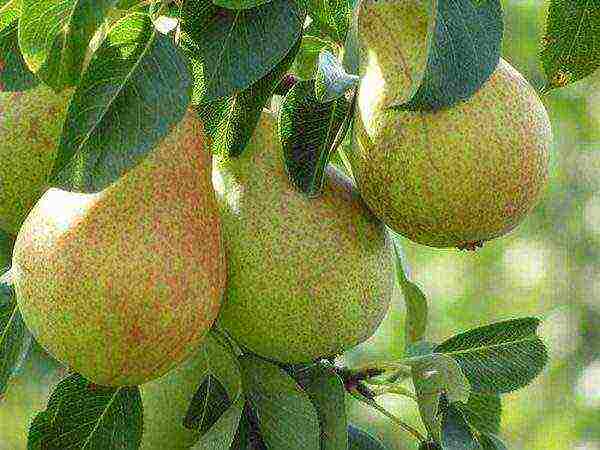 The Gera variety is famous for its large fruits.
The Gera variety is famous for its large fruits.
The same applies to winter varieties, which appeared as a result of crossing Reale Turin and Daughter of the Dawn. The variety is not particularly different from others, but because of its large fruits, it fell in love with gardeners. One pear can weigh up to 280 grams! In addition, the fruits have light green hues, which change to reddish during the ripening process. Not inferior in taste, pears are sweet, with fine-grained cream-colored pulp. They have a delicate, slightly sour taste, with a pleasant aroma.
The tree is medium-sized, no more than 6 m high, with spreading branches, crown, brownish color. Able to give a large amount of harvest annually, not picky about conditions and care. Plucked fruits can be stored for several months. In addition, the variety is quite resistant to diseases, not afraid of insects, frost-resistant.
In ancient Greece, pear fruits were used as a remedy for nausea.
Miracle woman
 Pear Miracle
Pear Miracle
Another winter pear, a hybrid obtained by crossing the Daughter of Zarya and Talgar beauty varieties. Possesses excellent resistance to frost and disease... It has a pyramidal crown shape, no more than 5 m high. The branches are thin, look up, gray-brown in color.The leaves are rounded, dark green in color, small light streaks are clearly visible. Blooms in early spring, with white fragrant inflorescences.
High yield variety, by weight one fruit from 140 to 210 grams, can remain on the tree for a long time and can be stored for a long time when assembled. Fruits are light green in color; towards autumn they become yellowish, slightly elongated. Sweet to taste, with fleshy pulp, have a delicate pleasant aroma.
Autumn
Autumn garden varieties differ from others in the long term storage in assembled form, they are not inferior in taste to summer or winter ones.
Veles
 Veles pear variety
Veles pear variety
Autumn pear variety, one of the best. The fruits are large enough, the average weight of a pear is from 150 grams and above... Fruits are regular pear-shaped: narrow at the stalk and rounded at the bottom. On the branches they grow in small clusters, 3-4 pears each. The Veles pear ripens at the end of August, remains on the tree until October. It has a beautiful appearance, until the end of summer, the fruits are dark green, and when ripe, they become red-orange tones. The taste is sweet, juicy, with fleshy pulp and thin skin.
The height of the tree is no more than 8 m, with drooping branches and a pyramidal shape of the trunk, gray-brown in color. Young branches are formed throughout the summer, which affects the amount of the harvest; it is recommended to prune in the fall. Resistant to frost, disease and pests.
Bere Moskovskaya
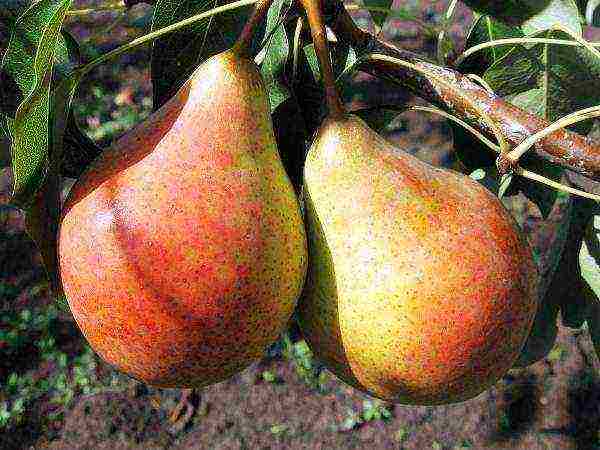 Bitter-tart pear variety Bere Moscowskaya
Bitter-tart pear variety Bere Moscowskaya
Frost-resistant, almost not exposed to diseases and pests. It appeared as a result of pollination of the Olga variety with pollen from the Lesnaya Krasavitsa and Lyubimitsa Klappa varieties. A tree no more than 6-8 m high... The crown of the pear is round, light brown in color. Young branches are rather thin, drooping, gray or brown in color. The leaf plate is dark green, rounded. The pear blooms in early spring.
Fruits are slightly bumpy, light green shades, there is a slight blush closer to autumn.It is best to remove fruits that are slightly green and firm in early autumn., so they keep better and stay longer, up to several months in a cool and dark place. If the pear tastes slightly tart, with sourness, it means that the pear lacks moisture. With proper care, the pear becomes sweet and fleshy, with a delicate white flesh. In general, this variety is not capricious when leaving.
Red-sided
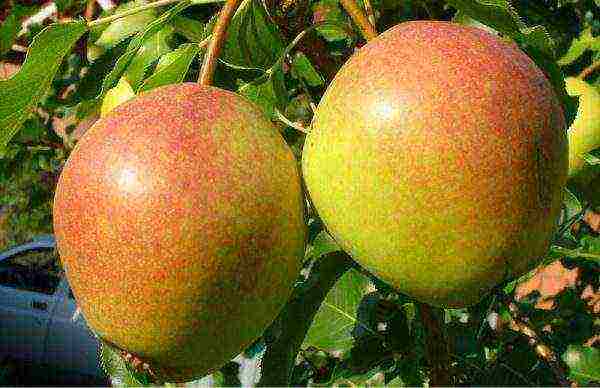 Pear variety Red-sided
Pear variety Red-sided
The misconception that this variety belongs to the winter, it is not, the variety is autumn ripening. It was obtained as a result of crossing the varieties Zheltoplodnaya and Tenderness. Resistant to diseases and pests, especially scab... It is frost-resistant, gives a good harvest from year to year. The crown is rounded, the branches are slightly drooping, brown-gray in color. Leaves are slightly pointed, light green shades in spring and dark green tones closer to autumn.
Does not require special care, can grow in small shade, under taller trees, but loves moisture. Fruits of medium size, weighing no more than 200 grams... Green pears change their shades to a raspberry blush as they ripen. Sweet to taste, with juicy fine-grained pulp and thin skin. Stick to branches, on short, curved stalks. The fruits are able to survive for a long time, both on the tree and in the harvested state, they are not afraid of transportation.
In memory of Yakovlev
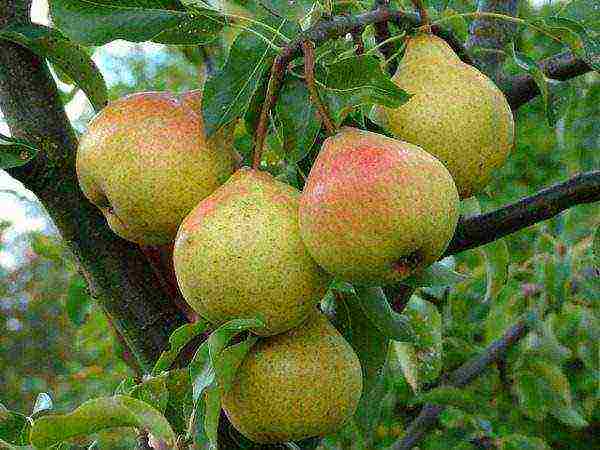 Pear variety of high winter hardiness in Memory of Yakovlev
Pear variety of high winter hardiness in Memory of Yakovlev
A medium-sized tree with a dense crown. The height of the tree does not exceed 1.5-2m, with a spherical crown. Young branches are thin, looking up, brown-gray in color with small thorns. The leaves are dark green, ovoid, with smooth edges. The harvest gives for 6-8 years... The Pamyati Yakovlev variety is popular among gardeners due to regular fruiting and unpretentious care.
Pears with smooth and thin skin, weighing no more than 200 grams. The fruits are collected in groups of 5-7 pears. The pear is sweet to taste, with juicy pulp and pleasant aroma.The fruits are golden in color, slightly reddish at the end of ripening. Full ripening of fruits occurs in mid-October.... The pear is stored on the tree for a long time, does not fall off, and in the assembled state it can lie for several months. High yield, which increases every year the tree grows. More than 30 kg of ripe pears are harvested from an adult tree per year. In addition, it is capable not only of self-pollination, but also pollinates other varieties of pears. It greatly simplifies the care of a pear that it is winter-hardy and unpretentious in care.
For the first time the word "pear" was mentioned in chronicles in the 12th century, and sounded like "hrusha". And all, because of the characteristic crunch, which was published when biting the fruit.
Muscovite
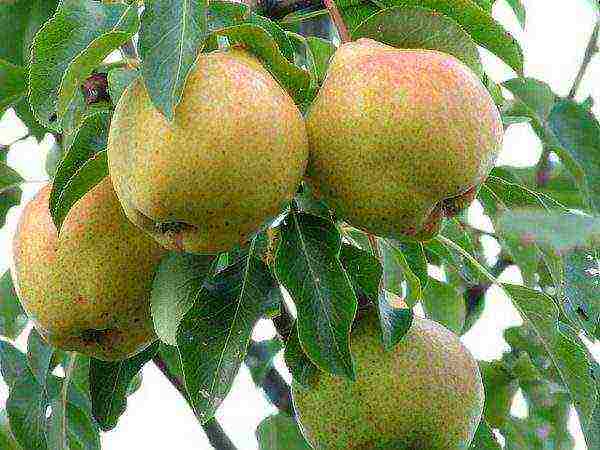 Branch of pear Moskvichka with fruits
Branch of pear Moskvichka with fruits
Obtained as a result of pollination of one of the American Kieffer pear varieties. Possesses a standard shape, with a rather dense and spreading crown, light gray colors, which eventually changes shades to brown tones. Forms new curved shoots quickly. The foliage is light green in color, with an oval shape, slightly curved in the center. This variety produces a bountiful harvest in the southwestern regions. The first harvest is formed in 3-4 years.
Muscovites are medium-sized fruits, up to 150 grams. They have the correct pear-shaped shape. They have a greenish-yellow hue, which changes towards burgundy-crimson tones by the end of summer. The skin is thin, fleshy with a juicy pulp with a pronounced sweet-sour taste. It is recommended to pick pears when they are slightly underripe, because after lying in the room for a couple of days, the pear ripens and retains its taste. Under the right storage conditions, the fruits are able not to spoil for several months.... High resistance to scab and rot, also not afraid of frost.
Marble
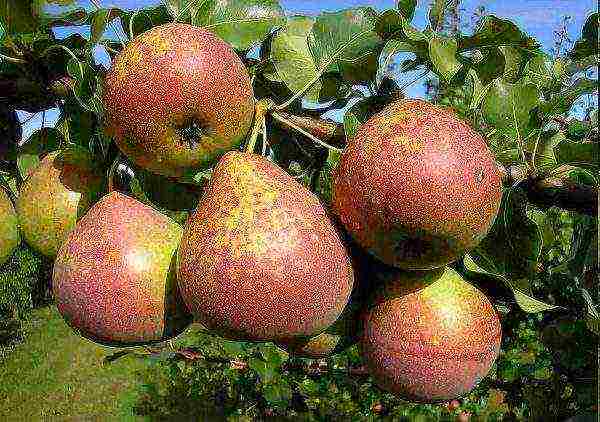 Marble pear fruits
Marble pear fruits
The fruit of the crossing of Bere Zimnaya Michurina and Lesnoy Krasavitsa varieties. The harvest of this variety ripens by the very beginning of autumn, the first fruits can be picked at the beginning of September. Differs from others in the height and density of the crown, the height of the tree is more than 8 m... Many light brown thin branches are formed every year, but pear shoots are extremely rare. Blooms in early spring with white fragrant inflorescences. The foliage is dark green in color.
The fruits are large, from 170 grams, with yellowish-green hues and a slight blush. The pear is also distinguished by the correct conical shape of the fruit. The pulp is coarse, tender, juicy. Rather dense rind, with small dots of a rusty color. The Marble variety, like other autumn pears, is frost-resistant, not afraid of diseases and pests. The tree begins to yield only 5 years, but the yield percentage is high, the pear is able to please with a large amount of harvest every year.
Pear for the Volga region and central Russia
Chizhovskaya
 Winter-hardy pear Chizhovskaya
Winter-hardy pear Chizhovskaya
Olga and Lesnaya Krasavitsa were taken as the "parental" varieties, as a result of the long work of S.T. Chizhov and S.P. Potapov and the Chizhovskaya variety was bred. One of the popular self-pollinated varieties in the middle lane, especially in the Volga region and surrounding areas... The tree is no more than 3 m high, the young tree has a narrow crown, grayish shades. Older branches acquire a brownish color, branches look up, medium in thickness, slightly curved. Leaves are oval, dark green in color with smooth edges.
By themselves, the fruits weighing no more than 150 grams. At the beginning of summer, the pear is of light green tones, the fruit is quite hard, but closer to autumn it acquires yellow shades and becomes soft. In this state, the Chizhovskaya pear will not hang on the tree for a long time, therefore it is recommended to pick it at the beginning of autumn. Green fruits can last for several weeks.... Sweet and fleshy on the palate, ripens in mid-August. They have a white, medium-grained pulp with a pleasant aroma. In addition, she inherited frost and disease resistance from her relatives.
The peculiarity of the variety is that the older the tree, the smaller the fruits.You can fight this with timely pruning.
Lada
 Pear Lada belongs to the early summer varieties
Pear Lada belongs to the early summer varieties
The result of crossing the varieties Lesnaya Krasavitsa and Olga, a variety suitable for planting in the middle lane. Differs in early maturity of fruits, you can taste fresh fruits already in the middle of summer... Lada is frost-resistant, is not susceptible to diseases and pests, and gives a rich harvest every year. A tree with a branchy crown, branches slightly drooping, looking down. The height of the tree is not more than 3 m, with a pyramidal trunk, closely gray in color. Leaves are shiny, smooth, dark green tones. It winters well enough even in the most severe winters, is resistant to diseases, partially self-fertile.
Medium-sized fruits, no more than 100 grams, light green tones with thin skin. Closer to ripening, the fruits give in yellow tones, become soft to the touch. It is important to take the moment to remove the fruits from the tree, otherwise they become soft, covered with rusty spots and fall off. The fruit is attached to the branches in pairs on short stalks. It tastes sweet, with a slight hint of sourness and can be stored for a long time when torn off, especially in a cool place.
Bessemyanka
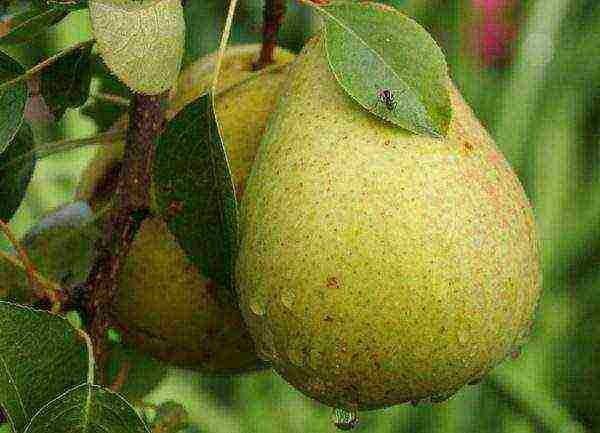 Pear Bessemyanka belongs to high-yielding varieties
Pear Bessemyanka belongs to high-yielding varieties
Popular and quite interesting for planting, especially spread in the Central regions, it also grows well in the middle lane. The tree is vigorous, the growth rate is fast, it yields consistently, does not need rest. The yield is high, more than 50 kg of fruits are harvested per year. The tree is more than 6 m high, with spreading and curved branches. The leaves are oval, dark green in color, with rounded edges. The variety is also resistant to frost, but prone to scab and other diseases.
Annually it pleases with a large amount of harvest, although the fruits are rather small, more like apples. Light green in color, firm when ripe, the fruits turn yellow and soft when ripe. Attached to branches, one fruit on short stalks. Ripening occurs at the end of summer, when the fruits become yellowish.... It does not last long on the tree, it quickly falls off. In addition, it does not lie for long and in a torn form, no more than 2-3 weeks.
In Europe, until the moment when tobacco was introduced, crushed pear leaves were used for smoking.
Skorospelka from Michurinsk
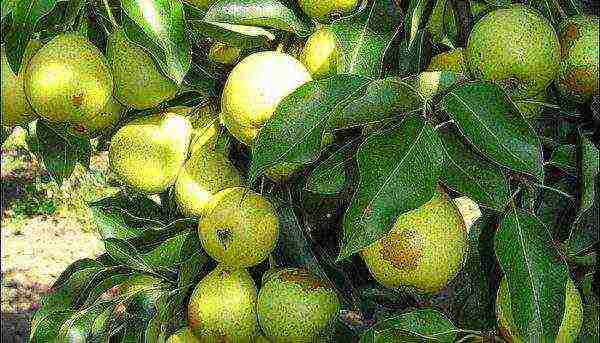 Pear Skorospelka from Michurinsk
Pear Skorospelka from Michurinsk
This variety breaks all records for the speed of fruit ripening. Bred by IV Michurin, as a result of crossing the varieties Citron de Carme and Bere Ligel. It belongs to the early varieties of pear, the harvest ripens by the middle of summer... It is a tall tree, the shape of the trunk is pyramidal, light brown in color.
Fruits no more than 90 grams, green in summer, acquire a yellow tint when fully ripe. Small fruits are offset by taste: sweet, juicy, this pear is loved not only by gardeners, but bees and birds. Therefore, it is better to collect them when they are a little hard, they are stored for no more than a week. The tree itself is winter-hardy, with a dense crown, resistant to diseases and pests.
Allegro
 Pear variety for the middle Allegro strip
Pear variety for the middle Allegro strip
Bred thanks to artificial pollination of the Osennyaya Yakovleva variety. Another variety for the middle lane, which bears fruit annually, is unpretentious in care, resistant to disease and severe cold. Fruiting begins at the age of 3 years, over time, the fruits become larger in size. Medium-sized tree, more than 5 m high, with a lowered crown. The branches are curved, light gray, the leaves are slightly elongated, closely green in color.
A pear weighing from 120 grams with a thick skin, but juicy and sweet pulp, with a spicy aroma. Correct pear-shaped, the fruits are slightly elongated. They are attached to the branches with a thick stalk, grow on a branch one by one. Ripening occurs at the beginning of August., the fruits turn yellowish-red and become soft. The variety is not stored for a long time, ripe fruits hang on the tree for no more than 2 weeks, but when assembled they can lie for more than a month.
The middle zone of Russia has a special climate that is not suitable for growing all varieties of pears. There are pronounced hot summers, severe winters, and transitional periods with a lot of precipitation. Only those who "love" this weather can grow and bear fruit here, and proper care will ensure a greater pear yield.
Garden varieties for the Moscow region, description
Prominent or Bumpy
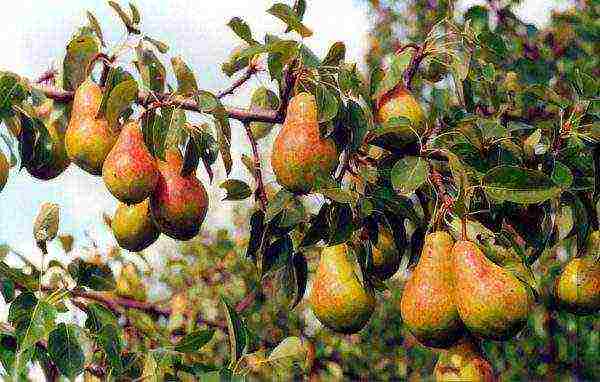 Pear variety Bumpy
Pear variety Bumpy
A pear variety that has long been loved by the Moscow region. A tree no more than 5 m high, with a fairly spreading young crown, which subsequently takes on a pyramidal shape. During the summer, the tree forms many young branches, which must be cut in autumn, otherwise the fruits will become smaller. The leaf plate is elongated, with light streaks, dark green in color. Blooms in early spring, many white inflorescences with a pleasant aroma.
Fruiting begins in the 5th year, fruits of medium size, regular pear-shaped. The color is greenish-yellow during the summer, with a red tint closer to autumn. Fruits with thick skin and coarse white flesh... Sweet and juicy on the palate, with a pleasant aroma. When harvested, it can last for several months, but it is recommended to harvest the fruits in mid-August, when the fruits are quite hard and slightly underripe.
Tenderness
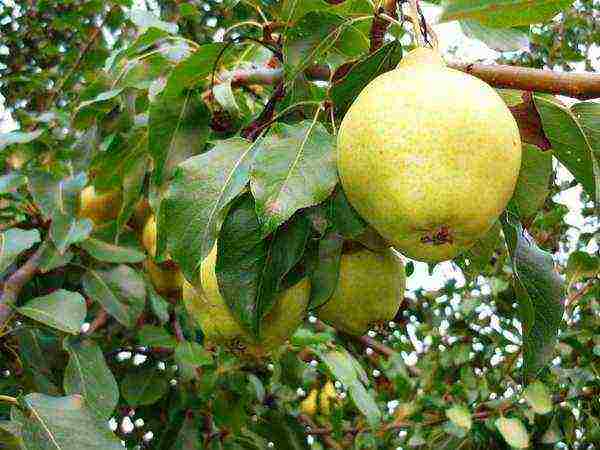 Hybrid variety Tenderness
Hybrid variety Tenderness
The variety obtained as a result of crossing Tyoma and Lyubimitsa Klapp. A particularly large amount of harvest gives in the Volga region, the middle lane and in the Moscow region... The tree is medium-sized, no more than 4 m in height, with a sparse crown. The branches are thin, light gray. The tree blooms in mid-spring, white, small inflorescences. The leaves are round, with smooth edges, smooth. Frost-resistant, capable of bearing fruit annually. It prefers to grow in sunny areas, is resistant to diseases, is not afraid of pests, so growing this variety will not be difficult.
Fruits are large, weighing more than 200 grams with a regular pear-shaped fruit... The pear tastes soft, juicy, coarse-grained with a pleasant aroma. Attached to branches with short stalks. In the middle of the fruit is a chamber with brown seeds. The fruits of this pear are preserved for a long time both on the tree and in the harvested form, especially at a temperature of 0 degrees.
The pear tree is not capable of deforming, which is why, for example, rulers for architects are made from it.
Fabulous
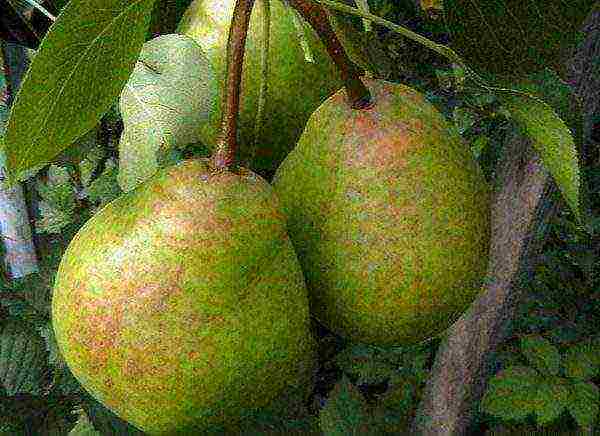 Pear Fairy is characterized as a tall and very productive variety.
Pear Fairy is characterized as a tall and very productive variety.
It got its name from the beautiful fruits. Obtained as a result of crossing the varieties Powislaya and Tenderness. The pear has a high yield, more than 30 kg of ripe fruits are harvested from one adult tree per season... The height of the tree reaches 4 m, the branches are dense, thin with a gray-brown crown. The leaf plate is smooth, rather small, of green shades, with small teeth along the edges.
When the pear ripens, it becomes yellow-reddish on one side and greenish on the other. Has the correct shape of the fruit, moreover one pear can weigh over 150 grams... The pulp of the pear is white, fleshy, medium-grained. In the center of the fruit are chambers with dark brown seeds. It tolerates diseases steadily, is not afraid of frost, seedlings easily take root in a new place.
Vera Yellow
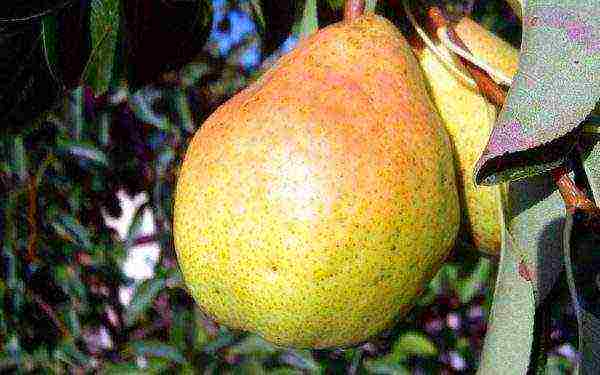 Vera Yellow
Vera Yellow
Another suitable variety for planting in the Moscow region. A tree with a height of more than 6 m, with a pyramidal trunk, with erect branches of a brown-brown color... Young leaves of light green tones, by autumn change color to dark green shades. Frost-resistant, does not need special care. The pear ripens in mid-September. It differs from others in that it has declines in yield, the fruits become smaller, but after a couple of years the pear again pleases with a large harvest.
Fruits have green hues throughout the summer, but change to yellow-orange colors closer to autumn. Fastens on short stalks, grows 2-3 pears in a bunch... To the taste, the pear is fragrant and fleshy, medium-grained pulp with a thin skin. Good storage capacity, especially in a cool place.
Elegant Efimova
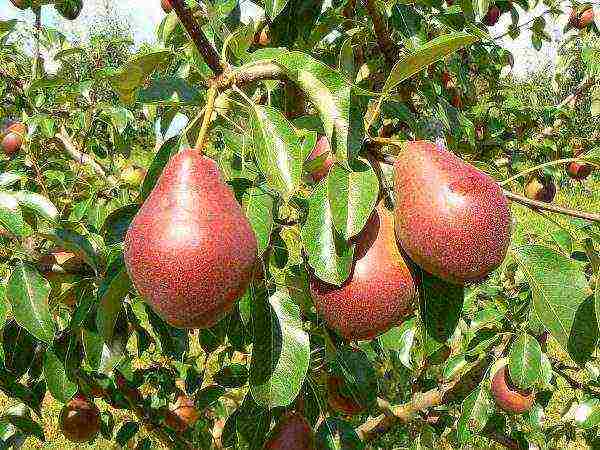 Variety Dressy Efimova
Variety Dressy Efimova
It turned out as a result of crossing the varieties Lyubimitsa Klappa and Tonkovotka. It grows well and gives a rich harvest in the Central Region, the Moscow Region and other nearby regions. High-yielding, winter-hardy, not subject to pests and diseases... The tree is tall, more than 5 m in height, with a dense crown, dark brown, pyramidal in shape. The leaves are small, dark green in color, with smooth edges.
Beautiful fruit appearance, red-orange tones are intertwined with green shades. But the fruits are small in size, weighing no more than 120 grams, regular, slightly distant shape. Soft, juicy pulp with a pleasant sweet aroma. The thin skin of the pear is prone to dark spots during the summer. Fruits ripen at the end of August, overripe quickly, so it is better to collect them a little hard, and it is recommended to store them in a cool and dark place.
Venus
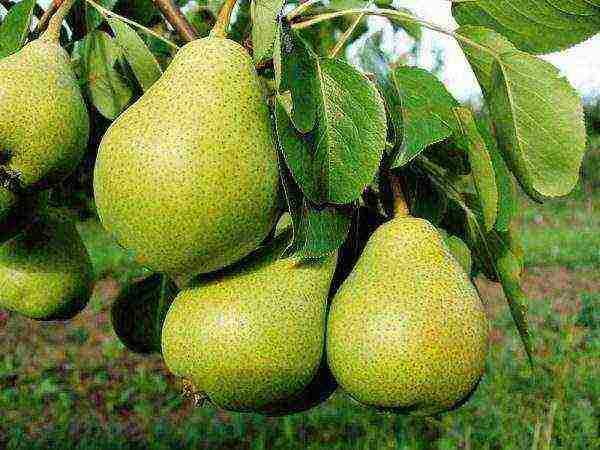 Pear venus
Pear venus
Another popular variety for planting, due to its winter hardiness and unpretentious care. Tree no more than 4m high, the crown is quite spreading, young branches are slightly lowered down, light brown in color. The variety blooms in early spring with white inflorescences with a sweet aroma. The variety also differs in high productivity, an adult tree is capable of producing more than 40 kg of harvest over the summer. Does not need rest, is able to bear fruit annually. In addition, the variety tolerates frosts, diseases and pests quite steadily.
The variety ripens in early autumn, the fruits are large, weighing up to 200 grams... Red-yellow in color, green tones when ripe. The taste is soft, juicy, slightly sour with a thin skin. They are stored for a long time both on the tree and when assembled.
Regardless of the specific variety, of which there are a huge variety today, the main thing in a pear is its taste and useful microelements, which are so abundant in ripe fruits. Winter, summer and autumn varieties differ from each other not only in taste, but also in the speed of fruit ripening., features of care, and the ability to preserve the fruit. Which variety to choose is up to you.
Among the huge variety of pears, winter varieties stand out for their long shelf life, frost resistance and suitability for conservation. We have selected winter varieties recognized by experts as the best in terms of yield.
The pear is more sensitive to frost than the apple tree, so breeders for a long time could not get truly winter-hardy varieties. But now this problem has been resolved. Even residents of the northern regions can find excellent pear varieties for themselves, which will be stored for several weeks, and sometimes months!
Why late varieties of pears are good
Among inexperienced gardeners, there is an opinion that winter pears are tasteless and hard. However, many people forget that the dates of removable and consumer maturity in winter pear varieties do not coincide. The removed fruits must lie down for some time before acquiring their characteristic taste characteristics.
The fruits of winter pears are distinguished by tender and sweet pulp, they contain a large amount of vitamins and useful biologically active substances.
The indisputable advantages of winter pear varieties are:
- long shelf life (5-6 months);
- resistance of the tree to severe frosts;
- rich taste and aroma that pears acquire in the ripening process;
- attractive fruit appearance;
- they can be preserved.
According to the shelf life, pears are divided into three groups:
- early winter (Kure, Nart, Noyabrskaya, Elena, Zolotovorotskaya, etc.) - stored in the refrigerator until mid-January - early February;
- winter (Saratovka, Kondratyevka, Pass-Crassan, Olivier de Serre, Kirghiz winter, etc.) - stored in the refrigerator until the end of March;
- late winter (Tikhonovka, Emerald, Zest of Crimea, Maria, Winter Dekanka, etc.) - stored until the beginning of May.
We have selected varieties suitable for most climatic zones, thanks to their winter hardiness and excellent taste.
Belarusian late
A variety that won't let you down. Fruits of the correct wide-pear-shaped shape. In the period of removable maturity (mid-September), these pears are green with light brown spots, subsequently a reddish-brown blush appears on them. During storage, the color of the fruit changes to yellow with orange spots and a raspberry blush. The pulp of Belorusskaya late is juicy, white, fine-grained, has a pleasant, sweet, slightly sour taste. Advantages of the variety: winter hardiness, high yield, excellent keeping quality.
| Entering fruiting | Tree height (m) | Fruit weight (g) | Harvest | Shelf life (days) | |
|
3-4 years |
Up to 4 |
110-120 |
Mid - end of September |
150-180 | |
Bere winter Michurina
In terms of yield, the trees of this variety, bred by IV Michurin himself, surpass many other varieties. Fruits are medium in size, classic pear-shaped, with slight asymmetry. The main color of pears is light green, subsequently a reddish blush appears on the skin. During storage, pears turn yellow, the blush becomes larger. The pulp of the fruit is white, juicy and firm, with a slight tart aftertaste. The variety is resistant to scab, but its winter hardiness is average.
| Entering fruiting | Tree height (m) | Fruit weight (g) | Harvest | Shelf life (days) | |
|
For 6-7 years |
4-5 |
120-140 |
End of September |
130-150 | |
Far East
An early winter fruitful variety of pears. Fruits are small, regular pear-shaped, yellow, with numerous brown blotches. Their flesh is white, juicy, with dense, hard lumps. Pears are delicious, sweet and sour, with a pleasant aroma and aftertaste (just let them sit). The advantages of the variety include high winter hardiness and absolute resistance to scab.
| Entering fruiting | Tree height (m) | Fruit weight (g) | Harvest | Shelf life (days) | |
|
For 4-5 years |
2-3 |
80-100 |
Third decade of September |
50-70 | |
Winter kubarevidny
The memorable name is associated with the fruits of a cuboid shape (rounded cube). Their skin is dense and rough, green in color, sometimes with a dull raspberry blush. During storage, small gray subcutaneous dots appear on it. The pulp is white, very juicy, with a rich sweet and sour taste. The variety is distinguished by good frost resistance and insensitivity to scab. In addition, the Winter kubarevidnaya annually pleases with a bountiful harvest, which is stored for up to 6 months.
| Entering fruiting | Tree height (m) | Fruit weight (g) | Harvest | Shelf life (days) | |
|
For 6-7 years |
3-4 |
180-200 |
Early October |
150-180 | |
Nika
"Goddess of Victory" among pears. The tree is medium-sized, the fruits are truncated-conical, rounded. The skin is smooth and oily, with a waxy coating. The main color of the fruit is greenish with red spots. During the period of consumer maturity, pears become light yellow, brownish-red spots cover the entire surface of the fruit. The pulp is creamy, medium density, fine-grained, buttery consistency. The taste is sweet with sourness. The variety is characterized by high winter hardiness, susceptible to scab diseases and entomosporiosis.
| Entering fruiting | Tree height (m) | Fruit weight (g) | Harvest | Shelf life (days) | |
|
For 5-6 years |
3-4 |
150-200 |
Second decade of September |
90-100 | |
May Day
Winter variety with a festive name. Fruits of regular shape with oily skin and waxy bloom. The main color of pears is green, with a pink blush on the side facing the sun. During the storage period, the fruits do not get sick (as it might seem), they just change color to greenish-yellow with a brown blush. The pulp is creamy, medium density, semi-oily, juicy, very aromatic.The taste is sweet and sour, with an implicit astringency. The variety is winter-hardy and absolutely resistant to fungal diseases.
| Entering fruiting | Tree height (m) | Fruit weight (g) | Harvest | Shelf life (days) | |
|
For 5-6 years |
3-4 |
150-220 |
Second decade of September |
220-250 | |
Saratovka
Variety - "middle", which belongs to the late autumn-early winter. The fruits are elongated pear-shaped, with a smooth, oily skin and small dots on it. The main color of pears is greenish-yellow; as they ripen, they acquire a bright golden-yellow color. The pulp is white, tender and soft with a pronounced sweet and sour taste, without astringency, very juicy. The pear tolerates winter well, but drought is worse. The variety is immune to pear scab and powdery mildew.
| Entering fruiting | Tree height (m) | Fruit weight (g) | Harvest | Shelf life (days) | |
|
For 4-5 years |
4-5 |
120-140 |
End of September |
120-150 | |
Saint Germain
The variety has been known since the 19th century under the name Good Louise. Despite its Western European origin, it is grown in Central Asia and other southern regions and temperate zones. The fruits are large, oblong-ovoid. The skin is thin, dense and firm, but sensitive to shock and damage, so fallen pears quickly rot. As it ripens, the pear changes color from light green to yellow. Rust points are scattered in large numbers on the surface of the fruit, sometimes they can form a continuous mesh or large spots (this is normal). The pulp is greenish-white, of medium density, with a fragrant aroma and refreshing taste, juicy and sweet.
| Entering fruiting | Tree height (m) | Fruit weight (g) | Harvest | Shelf life (days) | |
|
For 4-6 years |
Up to 6-7 |
180-220 |
End of September |
120-150 | |
January
Fresh treats for the New Year's table. Fruits are medium in size, broadly pear-shaped. The skin is smooth, rough, matte. The main color of the pear is greenish; during the period of consumer maturity, the fruits acquire a yellowish tint. On the sunlit side of the pear, over time, a brown tan appears, turning into a reddish blush. The subcutaneous dots are green, well visible. The pulp is white with a greenish tint, juicy and sweet. The variety is quite resistant to scab and severe frosts.
| Entering fruiting | Tree height (m) | Fruit weight (g) | Harvest | Shelf life (days) | |
|
3-4 years |
3-4 |
130-150 |
Mid - end of September |
120-150 | |
Winter varieties of pears are distinguished by high yields. And their fruits can be stored almost until the new harvest, becoming more tasty and aromatic over time. Set aside some space in your garden for them and you can enjoy your own delicious pears all year round.
Winter varieties of pears are distinguished by excellent winter hardiness and a long shelf life of the crop. But there are not so many winter varieties with high performance. The winter varieties with the highest quality indicators that can be grown in both warm and cold regions will be described below.
What are the features of winter pear varieties?
Fruits from winter combs of pears are always harvested before they ripen. They are collected, then packaged and hidden for 1-2 months. During this time, the fruits are filled with juice, ripen and acquire their natural pleasant pear taste and aroma.
The taste of pears of this type is always very sweet, they have a large proportion of sugars and vitamins in their composition, and therefore are very useful for children and adults in fresh and processed form.
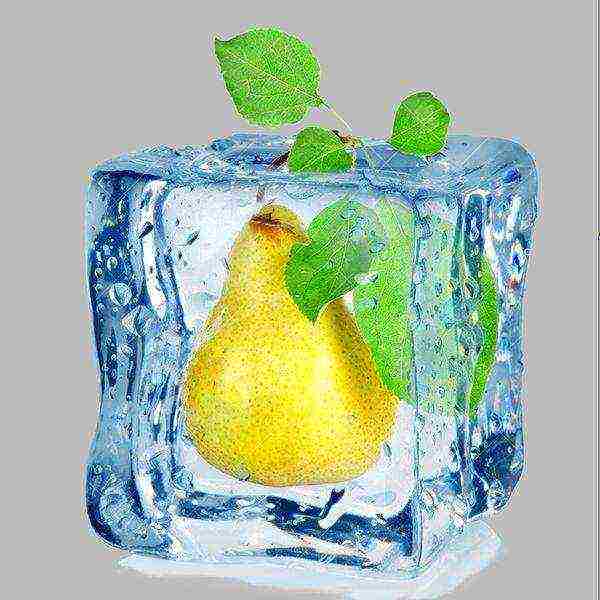
The shelf life of winter pears can be up to 6 months.
Winter pears can be stored for up to 6 months under good storage conditions. Trees are highly winter-hardy, but in the northernmost regions, they should still be insulated for the winter.
Often, winter pears are planted for fruit sale. After all, they, as a rule, are perfectly transported over any distance, and also have excellent commercial qualities.
The use is universal.Winter pears can be eaten fresh, canned, processed into juice, jam, frozen and dried.
Which varieties can withstand the coldest temperatures?
Winter pear varieties can withstand severe cold snaps, but frosts over -25 degrees are usually fatal for them. That is why pears are always insulated for the winter. And yet there are several varieties of pears that are very hardy in terms of low temperatures.
- "Nika" it has very good frost resistance. Colds down to -38 degrees are not terrible for her. Grows up to 4 meters. Fruits 150-200 g each with a smooth oily skin. The color is green, and after full ripening it is light yellow with red spots on the entire surface of the fruit. The pulp is fine-grained, sweet, oily consistency.
- "Hera" has excellent resistance to frost down to -38 degrees. The tree is of medium height, the crown is neat, compact. Fruiting begins from the 4th year of life. The yield reaches 40 kg / tree. It has an average resistance to disease and frost. Pears up to 250 g, reach technical maturity in mid-September. Fruits lie up to 5 months, then start to deteriorate.
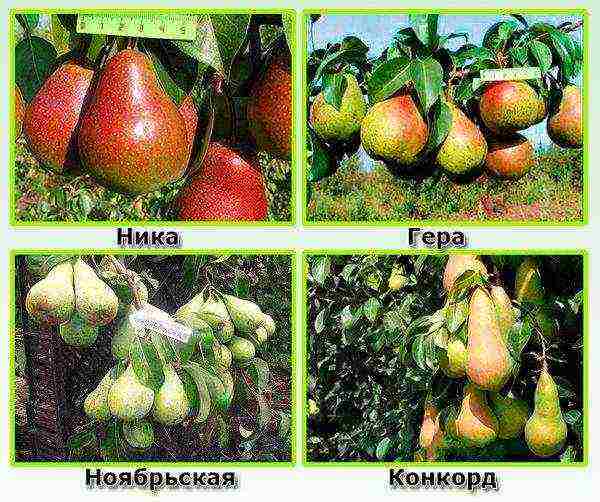
Which varieties can withstand the lowest temperatures
- "November" - winter variety of pears, not afraid of frosts down to -30 degrees. The tree grows up to 4-5 meters. The crown is spreading. Fruits are pear-shaped and vary in size from 70 to 350 g. Fruits are stored until April in good conditions.
- Concorde has similar characteristics with the "Conference" variety. It is harvested from late September or early October, while eating fruits can only be from mid-October. Fruits are stored until mid-February or March, then they begin to deteriorate. Withstand frosts down to -29.1 degrees Celsius. There is resistance to fungal diseases. The yield is high. Fruits up to 200 g, record weight - 350 g. Pear-shaped, elongated shape. The peel is oily, yellow with a red, blurred blush. The taste is sweet, the pulp is aromatic and juicy.
What are the most productive varieties of winter pears?
The most productive, winter varieties of pears allow harvesting from 100 kg of fruits or more from a tree per year. This amount allows you to make money selling them or preserve them for the winter.
- "Saint Germain" with good care, it can give up to 250 kg of pears from one tree per year. The fruits only slightly resemble a pear-shaped, they are longer, can be curved, weigh up to 220 g. The rind is thin, dense. The variety is prone to dropping, therefore it is worth picking the fruits immediately after ripening. The color is initially green, and after ripening, yellow with subcutaneous dots. The pulp is juicy, refreshing with a strong pleasant aroma.
- "Ardanpon" gives annually 180 kg of pears from one tree. Fruits weigh 170-220 g. Stored until January, have excellent transportability. Of the shortcomings, uneven ripening and rapid shedding of ripe fruits are noted. For winter, insulation is required, since frosts of more than -20 degrees may not survive.

What varieties of winter pears are the most productive
- "Curé" - a winter variety of pears, producing 100 kg of delicious fruits in one season from each tree. Vigorous, has a developed, extensive crown. Fruiting from 3 years of age. Fruits up to 250 g, are not stored for long. Already 2 months after full maturation, they begin to gradually deteriorate. The taste is normal, but consumers note that it is too bland, without a pronounced pear aroma.
- "Parisian" has a high yield - up to 100 kg per tree. Resistant to frost, bears fruit for 4 years after planting. The tree is of medium height. Fruits up to 180 grams, reach technical ripeness in October and are stored until the end of winter. It has good transportability, does not crumble and has an amicable ripening. Requires annual treatment for diseases and pests.
- "Dekanka Krasnokutskaya" yields up to 100 kg of fruits per year from a tree. Trees grow up to 3 meters. They should be insulated for the winter, since they cannot withstand severe frosts. Pears are yellow-green, with a shortened pear-shaped shape.The pulp is juicy, sweet when fully ripe. Harvested in September, eaten in a month, and it is stored until the end of February.
Which varieties are best kept?
Winter varieties of pears differ in that they are stored for a very long time, but which varieties can lie until the beginning of spring or even until May?
- "Pervomayskaya" the pear can be stored for up to 8 months! Fruits of 150 grams, there are also up to 200 g. The shape is correct, the consistency of the flesh is buttery, the taste is juicy, sweet with sourness and light astringency. The color of the fruit is green, and after ripening it is yellowish with reddish-brown spots all over the surface. It has a strong aroma. Fungal diseases are not affected.
- "Zest of Crimea" has very stable fruits. Under normal conditions, they lie for 7 months without changing the taste and quality of the pulp. Trees bear fruit since 4 years. The yield is high. Pears can grow up to 400 grams, the shape is typical, pear-shaped, golden color. The taste is pleasant, the pulp is tender, sweet and sour.
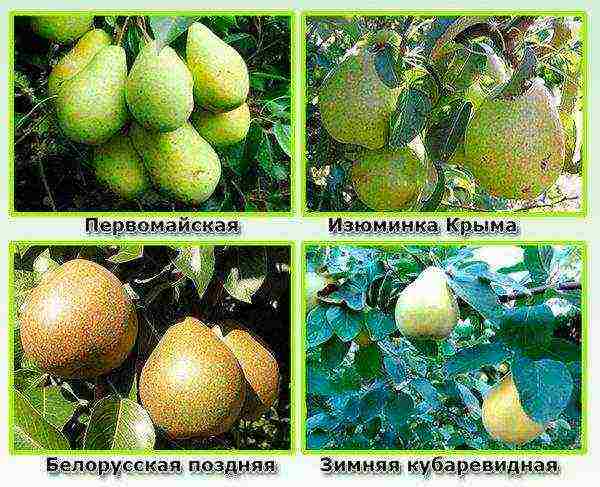
Which varieties are best kept
- "Belarusian late" stored for up to 6 months. Has a stable high yield. This winter pear variety ripens from mid-September. The fruits are 120 g each. The color of technical ripeness, when harvested, is green with a brown blush. A month after harvest, they acquire a yellow color with a blurred red flank. The pulp is juicy, fine-grained, there is sourness, but the main taste is sweet. The tree grows up to 4 meters, begins to bear fruit in 3 years.
- "Winter kubarevnaya" can lie 5-6 months after collection. The fruits are pear-shaped, with clear outlines, up to 200 g with a dense, coarse green skin and a brown blush. After full ripening, the pulp becomes white, juicy and sweet with a slight amount of acid. The tree grows up to 4 meters, the main disadvantages are late fruiting - 6-7 years.
VIDEO - November pear
The most popular fruit trees among gardeners after the apple tree, of course, are pears. Any gardener tries to grow this crop on his garden plot. But still, in this process, it is imperative to take into account the climatic zone. It is worth noting that not every selected variety can be grown in the middle zone of our country. For example, in the Moscow region there will be a not very favorable climate for growing many garden plants. But do not be upset, since the breeders have carried out a very difficult work regarding the creation of frost-resistant seedlings, which, moreover, have excellent resistance to various pests and diseases. Currently, many specialists have bred winter and autumn varieties of pears for cultivation in the harsh regions of the country. In this article, we will tell you exactly about this. From it you can learn a lot of valuable and useful information that will surely satisfy the requirements of almost any amateur gardener.
Autumn types of winter and autumn varieties of pears in their taste are practically not inferior to summer ones. The fruits begin to sing in the second half of September. Older plants are capable of producing a good harvest that can be stored for a long time in cool cellars. In addition, their holistic appearance and juiciness are not lost.

Popular varieties of autumn pears
In this article, you can find winter varieties of pears with a photo and with a name and description. It is worth noting that this article will help you in choosing a specific variety for your garden plot.
Marble.
This species is previously autumnal. It was bred by breeders by crossing the varieties Bere Mmchurina and Lesnaya Krasavitsa. This variety has a good yield for 6-7 years. Will require constant watering from its owner. According to many gardeners' reviews, this species can perfectly tolerate light frosts. In addition, they noted the excellent taste of the hearths: the pulp of this pear variety is very soft and grainy. It has a delicate and sweet taste.
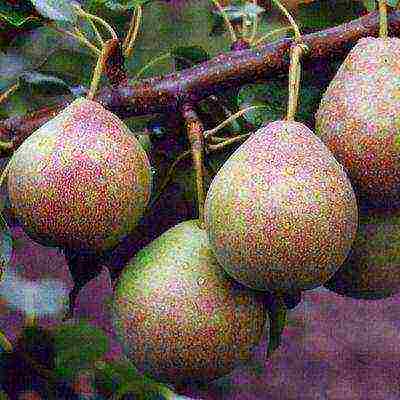
Bere bosk.
French autumn-winter types of pears are very popular in Russia. They are widely used for industrial purposes. They can perfectly adapt to various soils and perfectly tolerate frost. But still, the best productivity can be given on fertile soil. The fruits begin to sing in the first decade of autumn. Stored practically until December in a refrigerator. According to many experienced gardeners, the most valuable quality of this pear variety is that this culture is not affected by fungal disease (scab). The fruits are very attractive and large in size. They have a pale yellow tint and an oily, dense pulp.
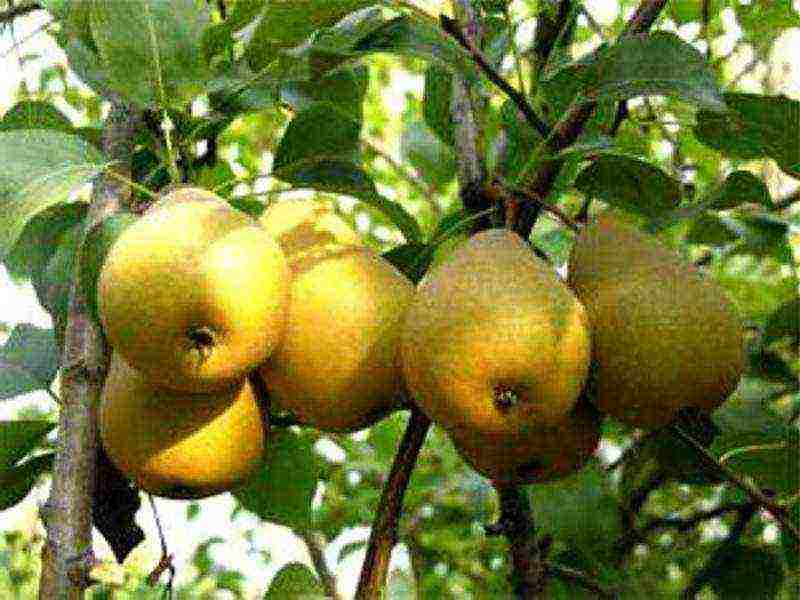
Elegant Efimova.
Here are the varieties of winter pears for you. It is very easy to find a photo and description of each variety. And this is very convenient. After all, such information will come in handy at the time of choosing a pear for the garden. In the course of a long work, breeders were still able to bring out autumn-winter varieties of pears for the Moscow region. One of these varieties is called elegant Efimovna. This pear variety has a long shape. Fruits are yellow-green in color, with a rich blush, and fleshy, juicy pulp. At the beginning of 1989, in the city of Erfurt, this variety was awarded a gold award for its unsurpassed taste and quality. The main advantages of this variety include excellent resistance to various fungal diseases and frosts. This pear variety is one of the few autumn varieties that are suitable for cultivation in the middle lane. Many gardeners are very happy to cultivate this variety in their summer cottages. people note many positive qualities of the harvest. The most important thing is not to overripe. Or the pulp will be very dry and mealy. After the harvest is fully harvested, the fruit can be stored for 2 weeks in cool, dry pestle at a constant temperature, which should not exceed 15 degrees above zero.
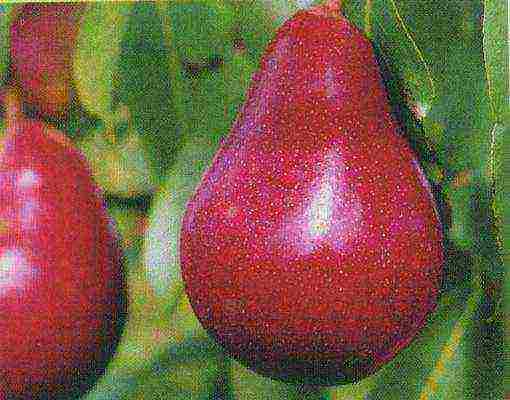
Favorite Yakovlev
According to numerous user reviews, the following can be noted: this variety is one of the most reliable in terms of frost resistance. The tree has a fairly large crown. and its fruits are very sweet. Every year this pear variety gives its owners an excellent harvest. Begins fruiting in the 6th year. And with the onset of autumn, you can already eat juicy and tasty pears. You can also start picking fruits that are not yet fully ripe, and put them in wooden containers or boxes, covered with paper. Thus, they can be missed for 2 months in a cool place.

Winter ripening varieties
Together with autumn pears, winter pear varieties are distinguished by their unsurpassed freshness and astringency. These varieties are successfully cultivated in the suburbs, since they can tolerate frost better than others, they are stored longer than others. They are also unpretentious in their care.
May Day.
Does not require soil soil for itself. It can perfectly tolerate dry weather, frost and is not susceptible to fungal diseases. According to gardeners, all of these factors are the main ones. And what is most interesting, the fruits of this variety almost never lose their freshness within 250 days. They have an attractive appearance and a slight waxy coating. The fruit tastes interesting.

Ukrainian pear variety "artyomovskaya winter"
Probably every gardener asks the question, which good winter variety of pear to choose? And it is important to note that many points should be taken into account here.
The next variety was bred in the city of Donetsk. It begins to bloom in the second half of December. The tree of this pear variety has a wide crown. The fruits are not subject to spoilage even at low temperatures. The culture can tolerate drought and hot weather excellently. Not demanding in care. The fruits are quite large. Reach a weight of 250 grams. The color of the fruit is bright yellow. Have a red blush.As a rule, this pear variety is silicified by large industrial organizations and amateur gardeners. The pods are also excellent for transportation. can be stored for a long time. According to most experts, the yield of this variety is simply amazing.
November winter.
This variety was bred by hybridizing the Nikolai Kruger variety and Vienne's triumph. He was able to gain great popularity in European countries for its unsurpassed quality and long preservation. The tree is not very large in appearance. It has a fairly spreading crown and elongated large fruits. They can weigh up to 500 grams. Practically not susceptible to diseases and scab. You can try to recognize the fruits of this variety by the rather dense skin, which has a pale yellow color. The very first harvest of this type of pear can be harvested after 4 years. you can plant young pear seedlings next to quince crops. It is necessary to store the fruits of winter pears in the cellar until spring. It should be noted that pear fruits will not spoil and change their taste. This is precisely their main advantage.
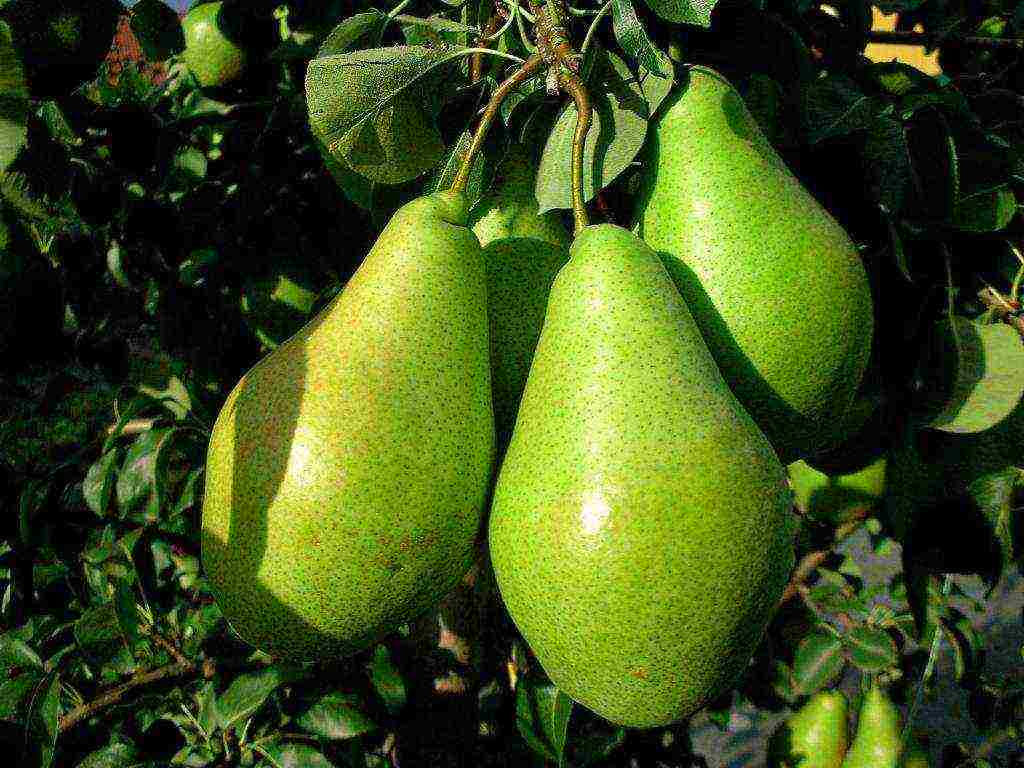
Belarusian late.
This pear variety was created from the seeds of the Kind Louise winter species. If we are talking about the best winter varieties of pears, then it is worth talking about the variety, Belarusian late. It pleases gardeners with good frost resistance, not very large crown, and average resistance to all kinds of diseases, as well as storage duration. After planting it, you should expect the very first harvest no earlier than 5 years later. There are many different reviews about this variety. And they are all positive. According to gardeners, a tree of this pear variety can bring a good and stable harvest every year. In addition, the quality of the fruits remains as good, their flesh is very sweet.
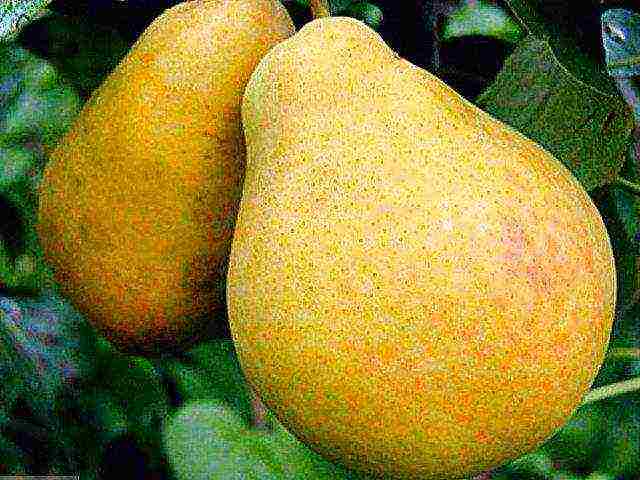
Charles Cognier.
Most of the winter types of pears for the regions of the Moscow region were bred by breeders in France. Charles Cognier is a very interesting and amazing variety. He is not afraid of frosts (up to minus 9 degrees). You can harvest the fruits with the onset of October. They are very delicate in structure and vaguely resemble chocolate.
Severyanka.
Created exclusively for harsh regions. A very popular variety. It is able to grow on different soils, also on clayey. The crown of the tree is quite voluminous. Constantly requires pruning from the gardener. Begins to bear fruit in the 3rd year after planting. Provides a sufficient amount of harvest. The fruits are bright yellow. have an average size. This variety is one of the most favorite varieties among amateur gardeners, since the pear fruits have a delicate and fine-grained structure. Many people prepare delicious desserts and preserves from the fruit. It should be noted that not all winter types of pears are preferred by culinary specialists. After undergoing heat treatment, the fruits practically do not change their shape, but remain just as healthy and tasty.
The decanter is winter.
This variety is also called winter duchess. The tree of such a pear is very large and massive. It has a very wide branched crown. Begins to bear fruit quite early. The fruits of the pear are lumpy, large. Despite such dimensions, it can very well adhere to the branches of a tree, it does not fall off for a long time. The skin of the fruit has a beautiful amber color. The pulp of the pear is very sweet and fleshy. Its main advantages include long storage time, excellent transportation and frost resistance. If you like pear, then you are probably interested in winter varieties for the Moscow region. And it is worth pointing out that we have listed these varieties for you above. Use this information and then the selection of the variety will be easy.
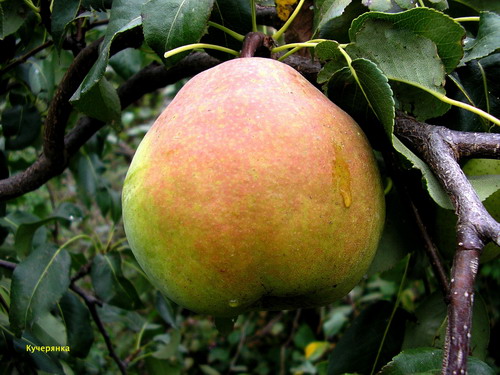
How to store winter pears in your home
The storage time of hearths depends on the degree of maturation.In order for the fruits to not lose their original appearance, oily structure and elasticity, they must be harvested at a certain time. Winter pear varieties have different ripeness periods. Most people think green fruits can ripen in the refrigerator. But this statement is fundamentally wrong. With this storage, the pulp of the pear will become hard and simply not suitable for consumption. This practice has been mastered by many unscrupulous exporters who want to get a lot of income without worrying about the final quality of the product. It should be noted that any variety requires an individual storage temperature.
Early autumn varieties must be stored in a room with a temperature of three degrees above zero, no more than 2 months. You can also extend the shelf life of fruits up to 150 days if the temperature is maintained at one degree. Before leaving the pears of winter varieties for storage, it will be necessary to prepare the proper conditions for them: the humidity in the room should not be lower than 85 percent. And the approximate temperature in the room should be at around 1-2 degrees. It is necessary to lay the fruits in special containers, or containers made of natural materials. In order for the fruits to not be able to deform and lose their original appearance, they should be laid using a checkerboard or diagonal method. The bottom of the container must be covered with shavings or paper.
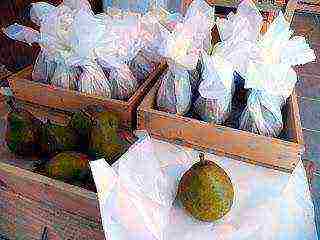
Useful information in conclusion
So, here were listed the autumn winter varieties of pears. According to many years of observations of leading agronomists and gardeners who have been cultivating winter varieties of pears for a long time, the more suitable varieties for the Moscow region are such varieties as: Belarusian late, northerner, artyomovskaya winter. The listed varieties can perfectly tolerate frosts (up to minus 10 degrees). At the same time, they are able to give a good harvest and very tasty fruits. Skeletal branches of a pear are not subject to sunburn and most diseases. Until now, an active study of a wide range of winter-hardy pear species, which could be excellent for cultivation in the middle zone of our country, continues.

